
EC200U&EG915U Series
HTTP(S) Application Note
LTE Standard Module Series
Version: 1.1
Date: 2021-08-20
Status: Released

LTE Standard Module Series
EC200U&EG915U_Series_HTTP(S)_Application_Note 1 / 50
Our aim is to provide customers with timely and comprehensive service. For any assistance,
please contact our company headquarters:
Quectel Wireless Solutions Co., Ltd.
Building 5, Shanghai Business Park Phase III (Area B), No.1016 Tianlin Road, Minhang District, Shanghai
200233, China
Tel: +86 21 5108 6236
Email: info@quectel.com
Or our local office. For more information, please visit:
http://www.quectel.com/support/sales.htm.
For technical support, or to report documentation errors, please visit:
http://www.quectel.com/support/technical.htm
Or email to support@quectel.com.
General Notes
Quectel offers the information as a service to its customers. The information provided is based upon
customers’ requirements. Quectel makes every effort to ensure the quality of the information it makes
available. Quectel does not make any warranty as to the information contained herein, and does not
accept any liability for any injury, loss or damage of any kind incurred by use of or reliance upon the
information. All information supplied herein is subject to change without prior notice.
Disclaimer
While Quectel has made efforts to ensure that the functions and features under development are free
from errors, it is possible that these functions and features could contain errors, inaccuracies and
omissions. Unless otherwise provided by valid agreement, Quectel makes no warranties of any kind,
implied or express, with respect to the use of features and functions under development. To the maximum
extent permitted by law, Quectel excludes all liability for any loss or damage suffered in connection with
the use of the functions and features under development, regardless of whether such loss or damage
may have been foreseeable.
Duty of Confidentiality
The Receiving Party shall keep confidential all documentation and information provided by Quectel,
except when the specific permission has been granted by Quectel. The Receiving Party shall not access
or use Quectel’s documentation and information for any purpose except as expressly provided herein.
Furthermore, the Receiving Party shall not disclose any of the Quectel's documentation and information
to any third party without the prior written consent by Quectel. For any noncompliance to the above
requirements, unauthorized use, or other illegal or malicious use of the documentation and information,
Quectel will reserve the right to take legal action.

LTE Standard Module Series
EC200U&EG915U_Series_HTTP(S)_Application_Note 2 / 50
Copyright
The information contained here is proprietary technical information of Quectel. Transmitting, reproducing,
disseminating and editing this document as well as using the content without permission are forbidden.
Offenders will be held liable for payment of damages. All rights are reserved in the event of a patent grant
or registration of a utility model or design.
Copyright © Quectel Wireless Solutions Co., Ltd. 2021. All rights reserved.

LTE Standard Module Series
EC200U&EG915U_Series_HTTP(S)_Application_Note 3 / 50
About the Document
Revision History
Version
Date
Author
Description
-
2021-04-28
Herry GENG
Creation of the document
1.0
2020-05-06
Herry GENG
First official release
1.1
2021-08-20
Herry GENG
Added an applicable module series EG915U.

LTE Standard Module Series
EC200U&EG915U_Series_HTTP(S)_Application_Note 4 / 50
Contents
About the Document ................................................................................................................................... 3
Contents ....................................................................................................................................................... 4
Table Index ................................................................................................................................................... 6
1 Introduction .......................................................................................................................................... 7
1.1. The Process of Using HTTP(S) AT Commands ...................................................................... 7
1.2. Description of HTTP(S) Request Header ................................................................................ 8
1.2.1. Customize HTTP(S) Request Header ............................................................................. 8
1.2.2. Output HTTP(S) Response Header ................................................................................. 8
1.3. Description of Data Mode ........................................................................................................ 8
2 Description of HTTP(S) AT Commands ........................................................................................... 10
2.1. AT Command Introduction ..................................................................................................... 10
2.1.1. Definitions ....................................................................................................................... 10
2.1.2. AT Command Syntax ..................................................................................................... 10
2.2. Declaration of AT Command Examples ................................................................................ 11
2.3. AT Command Description ..................................................................................................... 11
2.3.1. AT+QHTTPCFG Configure Parameters for HTTP(S) Server ..................................... 11
2.3.2. AT+QHTTPURL Set URL of HTTP(S) Server ............................................................. 15
2.3.3. AT+QHTTPGET Send GET Request to HTTP(S) Server ........................................... 16
2.3.4. AT+QHTTPGETEX Send GET Request to HTTP(S) Server to Get Data with Specified
Range 18
2.3.5. AT+QHTTPPOST Send POST Request to HTTP(S) Server via UART/USB ............. 19
2.3.6. AT+QHTTPPOSTFILE Send POST Request to HTTP(S) Server via File .................. 21
2.3.7. AT+QHTTPPUT Send PUT Request to HTTP(S) Server via UART/USB .................. 23
2.3.8. AT+QHTTPPUTFILE Send PUT Request to HTTP(S) Server via File ....................... 25
2.3.9. AT+QHTTPREAD Read Response from HTTP(S) Server via UART/USB ................ 26
2.3.10. AT+QHTTPREADFILE Read Response from HTTP(S) Server via File ..................... 27
2.3.11. AT+QHTTPSTOP Cancel HTTP(S) Request .............................................................. 28
3 Examples ............................................................................................................................................ 29
3.1. Access to HTTP Server ......................................................................................................... 29
3.1.1. Send HTTP GET Request and Read the Response ..................................................... 29
3.1.2. Send HTTP POST Request and Read the Response ................................................... 30
3.1.2.1. HTTP POST Body Obtained from UART/USB ..................................................... 30
3.1.2.2. HTTP POST Body Obtained from File System .................................................... 31
3.1.3. Send HTTP PUT Request and Read the Response ..................................................... 32
3.1.3.1. HTTP PUT Body Obtained from UART/USB ........................................................ 32
3.1.3.2. HTTP PUTBody Obtained from File System ........................................................ 34
3.2. Access to HTTPS Server ...................................................................................................... 35
3.2.1. Send HTTPS GET Request and Read the Response ................................................... 35
3.2.2. Send HTTPS POST Request and Read the Response ................................................ 36
3.2.2.1. HTTPS POST Body Obtained from UART/USB .................................................. 36

LTE Standard Module Series
EC200U&EG915U_Series_HTTP(S)_Application_Note 5 / 50
3.2.2.2. HTTPS POST Body Obtained from File System .................................................. 38
3.2.3. Send HTTPS PUT Request and Read the Response ................................................... 39
3.2.3.1. HTTPS PUT Body Obtained from UART/USB ..................................................... 39
3.2.3.2. HTTPS PUT Body Obtained from File System .................................................... 41
4 Error Handling .................................................................................................................................... 43
4.1. Executing HTTP(S) AT Commands Fails .............................................................................. 43
4.2. PDP Activation Fails .............................................................................................................. 43
4.3. DNS Parse Fails .................................................................................................................... 43
4.4. Entering Data Mode Fails ...................................................................................................... 44
4.5. Sending GET/POST Requests Fails ..................................................................................... 44
4.6. Reading Response Fails ....................................................................................................... 45
5 Summary of ERROR Codes .............................................................................................................. 46
6 Summary of HTTP(S) Response Codes .......................................................................................... 48
7 Appendix References ........................................................................................................................ 49

LTE Standard Module Series
EC200U&EG915U_Series_HTTP(S)_Application_Note 6 / 50
Table Index
Table 1: Type of AT Commands and Responses ....................................................................................... 10
Table 2: Summary of Error Codes .............................................................................................................. 46
Table 3: Summary of HTTP(S) Response Codes ...................................................................................... 48
Table 4: Related Documents ...................................................................................................................... 49
Table 5: Terms and Abbreviations .............................................................................................................. 49

LTE Standard Module Series
EC200U&EG915U_Series_HTTP(S)_Application_Note 7 / 50
1 Introduction
Quectel LTE Standard EC200U and EG915U series modules provide HTTP(S) applications to HTTP(S)
server.
Hypertext Transfer Protocol (HTTP) is an application layer protocol for distributed, collaborative,
hypermedia information systems.
Hypertext Transfer Protocol Secure (HTTPS) is a variant of the standard web transfer protocol (HTTP)
that adds a layer of security on the data in transit through a secure socket layer (SSL) or transport layer
security (TLS) protocol connection. The main purpose of HTTPS development is to provide identity
authentication for website servers and protect the privacy and integrity of exchanged data.
This document is a reference guide to all the AT commands defined for HTTP(S).
1.1. The Process of Using HTTP(S) AT Commands
With TCP/IP AT commands applicable for EC200U and EG915U series modules, a PDP context can be
configured, namely activate/deactivate the PDP context and query the context status. With EC200U and
EG915U series HTTP(S) AT commands, HTTP(S) GET/POST requests can be sent to HTTP(S) server,
HTTP(S) response can be read from HTTP(S) server. The general process is as follows:
Step 1: Configure <APN>, <username>, <password> and other parameters of a PDP context by
AT+QICSGP. See document [1] for details.
Step 2: Activate the PDP context by AT+QIACT, then the assigned IP address can be queried by
AT+QIACT?. See document [1] for details.
Step 3: Configure the PDP context ID and SSL context ID by AT+QHTTPCFG.
Step 4: Configure SSL context parameters by AT+QSSLCFG. For more details, see document [2].
Step 5: Set HTTP(S) URL by AT+QHTTPURL.
Step 6: Send HTTP(S) request. AT+QHTTPGET can be used for sending HTTP(S) GET request, and
AT+QHTTPPOST or AT+QHTTPPOSTFILE can be used for sending HTTP(S) POST request,
and AT+QHTTPPUT or AT+QHTTPPUTFILE can be used for sending HTTP(S) PUT request.
Step 7: Read HTTP(S) response information by AT+QHTTPREAD or AT+QHTTPREADFILE.

LTE Standard Module Series
EC200U&EG915U_Series_HTTP(S)_Application_Note 8 / 50
Step 8: Deactivate the PDP context by AT+QIDEACT. For more details, See document [1].
1.2. Description of HTTP(S) Request Header
1.2.1. Customize HTTP(S) Request Header
HTTP(S) request header is filled by the module automatically. HTTP(S) request header can be
customized by configuring <request_header> as 1 via AT+QHTTPCFG, and then inputting HTTP(S)
request header according to the following requirements:
⚫ Follow HTTP(S) request header syntax.
⚫ The value of URI in HTTP(S) request line and the “Host:” request header must be in line with the URL
configured by AT+QHTTPURL.
⚫ The HTTP(S) request header must end with <CR><LF>.
The following example shows a valid HTTP(S) POST request header:
POST /processorder.php HTTP/1.1<CR><LF>
Host: 220.180.239.212:8011<CR><LF>
Accept: */*<CR><LF>
User-Agent: QUECTEL_MODULE<CR><LF>
Connection: Keep-Alive<CR><LF>
Content-Type: application/x-www-form-urlencoded<CR><LF>
Content-Length: 48<CR><LF>
<CR><LF>
Message=1111&Appleqty=2222&Orangeqty=3333&find=1
1.2.2. Output HTTP(S) Response Header
HTTP(S) response header will not be outputted automatically. HTTP(S) response header information can
be obtained by configuring <response_header> to 1 via AT+QHTTPCFG, and then HTTP(S) response
header will be outputted with HTTP(S) response body after executing AT+QHTTPREAD or
AT+QHTTPREADFILE.
1.3. Description of Data Mode
The COM port of the above applicable EC200U and EG915U series modules have two working modes:
AT command mode and data mode. In AT command mode, the inputted data via COM port will be
regarded as AT command. While in data mode, it will be regarded as data.

LTE Standard Module Series
EC200U&EG915U_Series_HTTP(S)_Application_Note 9 / 50
Inputting +++ or pulling up DTR (AT&D1 should be set first) can make the COM port exit from data mode.
To prevent the +++ from being misinterpreted as data, the following sequence should be followed:
1) Do not input any character within 1s or longer before inputting +++.
2) Input +++ within 1 s, and no other characters can be inputted during the time.
3) Do not input any character within 1 s after +++ has been inputted.
When AT+QHTTPURL, AT+QHTTPPOST, AT+QHTTPPUT and AT+QHTTPREAD are executed, the
COM port will enter data mode. If +++ or DTR is used to make the port exit from data mode, the executing
procedure of these commands will be interrupted before the response is returned. In such case, the COM
port cannot reenter data mode by executing ATO command.

LTE Standard Module Series
EC200U&EG915U_Series_HTTP(S)_Application_Note 10 / 50
2 Description of HTTP(S) AT Commands
2.1. AT Command Introduction
2.1.1. Definitions
⚫ <CR> Carriage return character.
⚫ <LF> Line feed character.
⚫ <...> Parameter name. Angle brackets do not appear on command line.
⚫ [...] Optional parameter of a command or an optional part of TA information response.
Square brackets do not appear on command line. When an optional parameter is
omitted, the new value equals its previous value or its default setting, unless otherwise
specified.
⚫ Underline Default setting of a parameter.
2.1.2. AT Command Syntax
The AT or at prefix must be added at the beginning of each command line. Entering <CR> will terminate a
command line. Commands are usually followed by a response that includes
<CR><LF><response><CR><LF>. Throughout this document, only the response <response> will be
presented, <CR><LF> are omitted intentionally.
Table 1: Type of AT Commands and Responses
Command Type
Syntax
Description
Test Command
AT+<cmd>=?
Test the existence of corresponding Write
Command and to give information about
the type, value, or range of its parameter.
Read Command
AT+<cmd>?
Check the current parameter value of a
corresponding Write Command.
Write Command
AT+<cmd>=<p1>[,<p2>[,<p3>[...]]]
Set user-definable parameter value.
Execution Command
AT+<cmd>
Return a specific information parameter or
perform a specific action.

LTE Standard Module Series
EC200U&EG915U_Series_HTTP(S)_Application_Note 11 / 50
2.2. Declaration of AT Command Examples
The AT command examples in this document are provided to help you familiarize with AT commands and
learn how to use them. The examples, however, should not be taken as Quectel’s recommendation or
suggestions about how you should design a program flow or what status you should set the module into.
Sometimes multiple examples may be provided for one AT command. However, this does not mean that
there exists a correlation among these examples and that they should be executed in a given sequence.
2.3. AT Command Description
2.3.1. AT+QHTTPCFG Configure Parameters for HTTP(S) Server
The command configures the parameters for HTTP(S) server, including configuring a PDP context ID,
customizing HTTP(S) request header, outputting HTTP(S) response header and querying SSL settings. If
the Write Command only executes one parameter, it will query the current settings.
AT+QHTTPCFG Configure Parameters for HTTP(S) Server
Test Command
AT+QHTTPCFG=?
Response
+QHTTPCFG: "contextid",(range of supported <contextID>s)
+QHTTPCFG: "requestheader",(list of supported <request
_header>s)
+QHTTPCFG: "responseheader",(list of supported <respo
nse_header>s)
+QHTTPCFG: "sslctxid",(range of supported <sslctxID>s)
+QHTTPCFG: "contenttype",(range of supported <content
_type>s)
+QHTTPCFG: "rspout/auto",(list of supported <auto_outrs
p>s)
+QHTTPCFG: "closed/ind",(list of supported <closedind>s)
+QHTTPCFG: "url",<url_value>
+QHTTPCFG: "header",<header_value>
+QHTTPCFG: "auth",<user_pwd>
+QHTTPCFG: "form/data",<name>,<file_name>,<content_t
ype>
+QHTTPCFG: "reset"
OK
Write Command
AT+QHTTPCFG="contextid"[,<cont
extID>]
Response
If the optional parameter is omitted, query the current settings:
+QHTTPCFG: "contextid",<contextID>
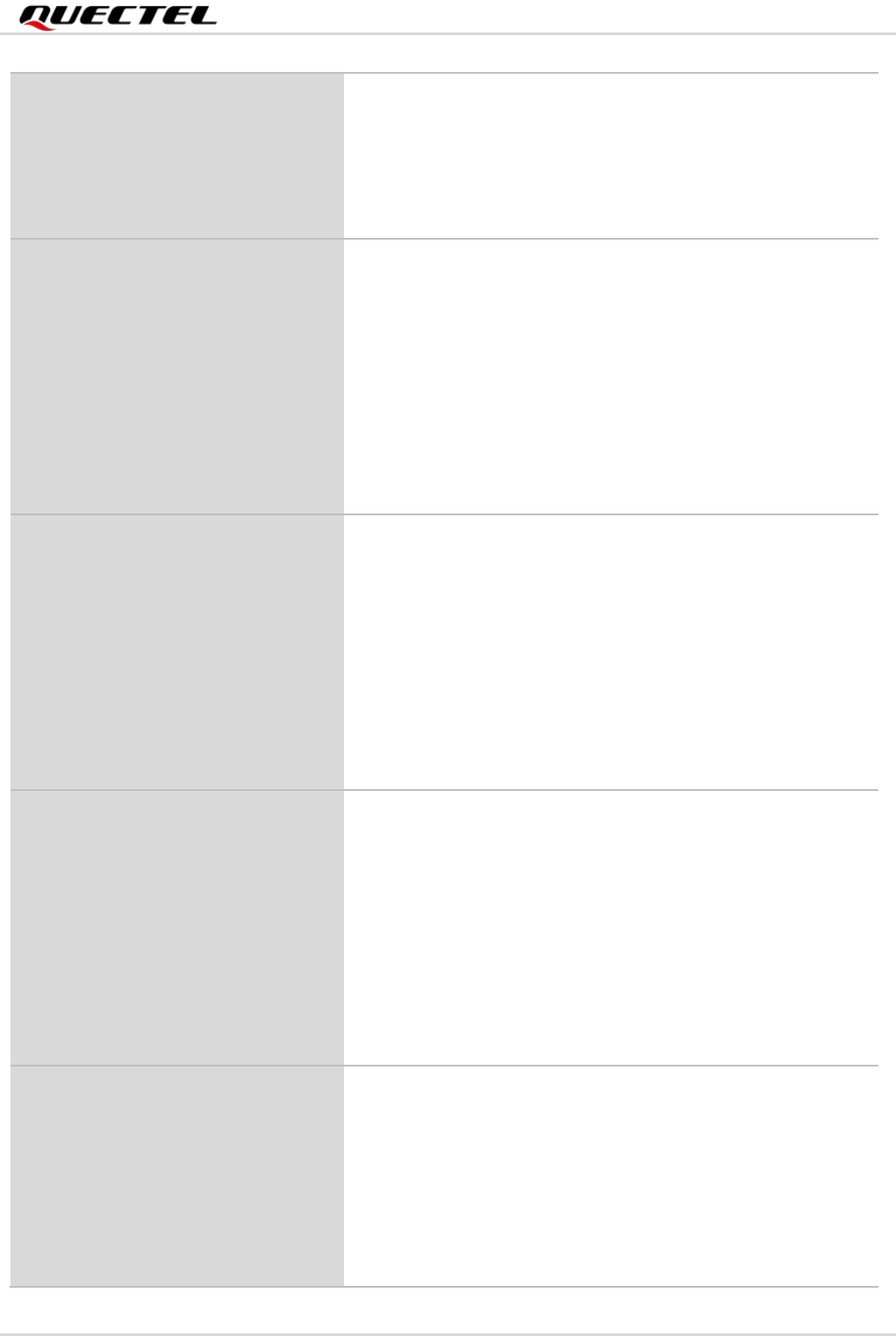
LTE Standard Module Series
EC200U&EG915U_Series_HTTP(S)_Application_Note 12 / 50
OK
If the optional parameter is specified:
OK
Or
+CME ERROR: <err>
Write Command
AT+QHTTPCFG="requestheader"[,<
request_header>]
Response
If the optional parameter is omitted, query the current settings:
+QHTTPCFG: "requestheader",<request_header>
OK
If the optional parameter is specified:
OK
Or
+CME ERROR: <err>
Write Command
AT+QHTTPCFG="responseheader"[
,<response_header>]
Response
If the optional parameter is omitted, query the current settings:
+QHTTPCFG: "responseheader",<response_header>
OK
If the optional parameter is specified:
OK
Or
+CME ERROR: <err>
Write Command
AT+QHTTPCFG="sslctxid"[,<sslctxI
D>]
Response
If the optional parameter is omitted, query the current settings:
+QHTTPCFG: "sslctxid",<sslctxID>
OK
If the optional parameter is specified:
OK
Or
+CME ERROR: <err>
Write Command
AT+QHTTPCFG="contenttype"[,<co
ntent_type>]
Response
If the optional parameter is omitted, query the current settings:
+QHTTPCFG: "contenttype",<content_type>
OK
If the optional parameter is specified:
OK
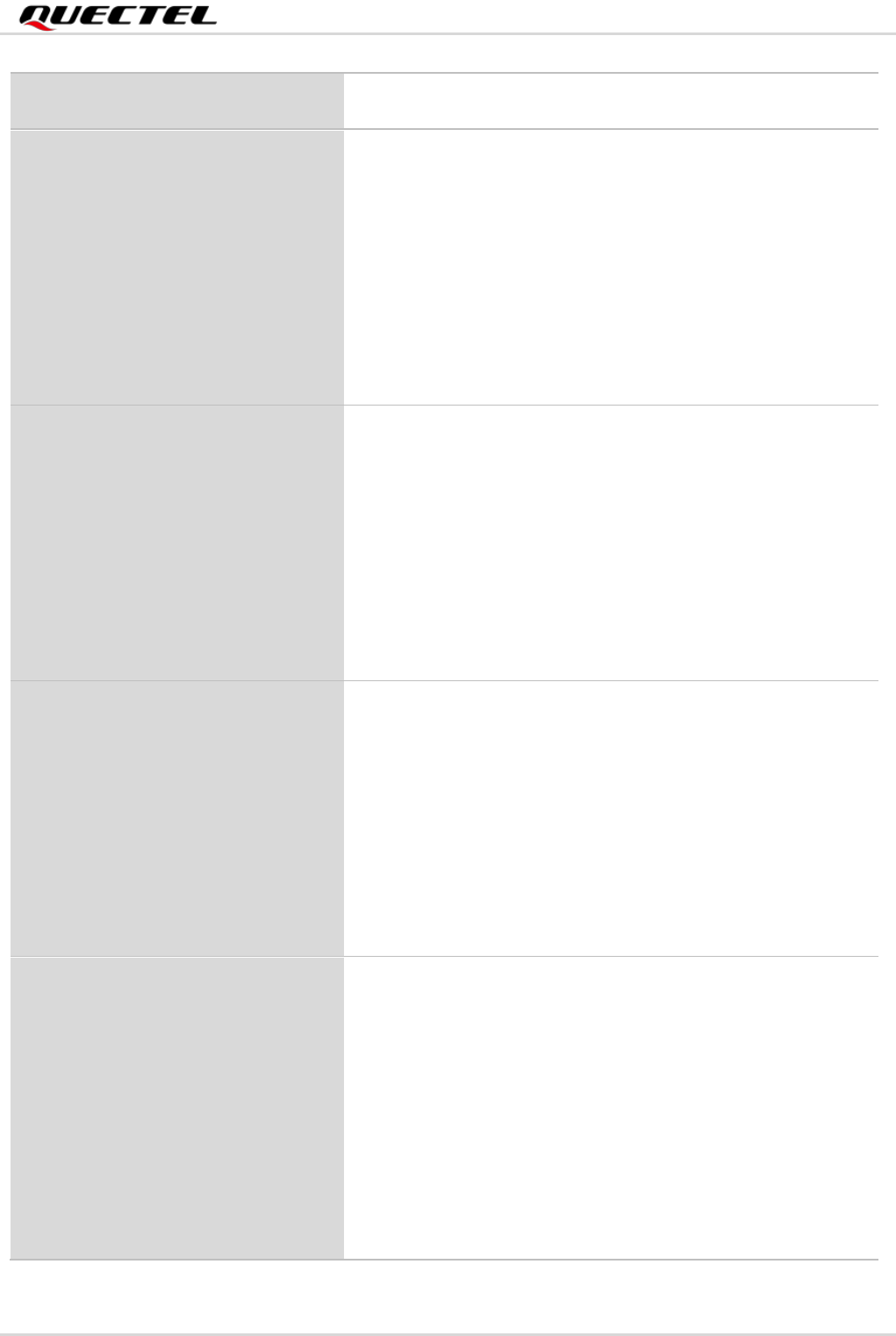
LTE Standard Module Series
EC200U&EG915U_Series_HTTP(S)_Application_Note 13 / 50
Or
+CME ERROR: <err>
Write Command
AT+QHTTPCFG="rspout/auto"[,<au
to_outrsp>]
Response
If the optional parameter is omitted, query the current settings:
+QHTTPCFG: "rspout/auto",<auto_outrsp>
OK
If the optional parameter is specified:
OK
Or
+CME ERROR: <err>
Write Command
AT+QHTTPCFG="closed/ind"[,<clos
edind>]
Response
If the optional parameter is omitted, query the current settings:
+QHTTPCFG: "closed/ind",<closedind>
OK
If the optional parameter is specified:
OK
Or
+CME ERROR: <err>
Write Command
AT+QHTTPCFG="url"[,<url_value>]
Response
If the optional parameter is omitted, query the current settings:
+QHTTPCFG: "url",<url_value>
OK
If the optional parameter is specified:
OK
Or
+CME ERROR: <err>
Write Command
AT+QHTTPCFG="header"[,<header
_value>]
Response
If the optional parameter is omitted, query the current settings:
+QHTTPCFG: "header",<header_value>
[…]
OK
If the optional parameter is specified:
OK
Or
+CME ERROR: <err>
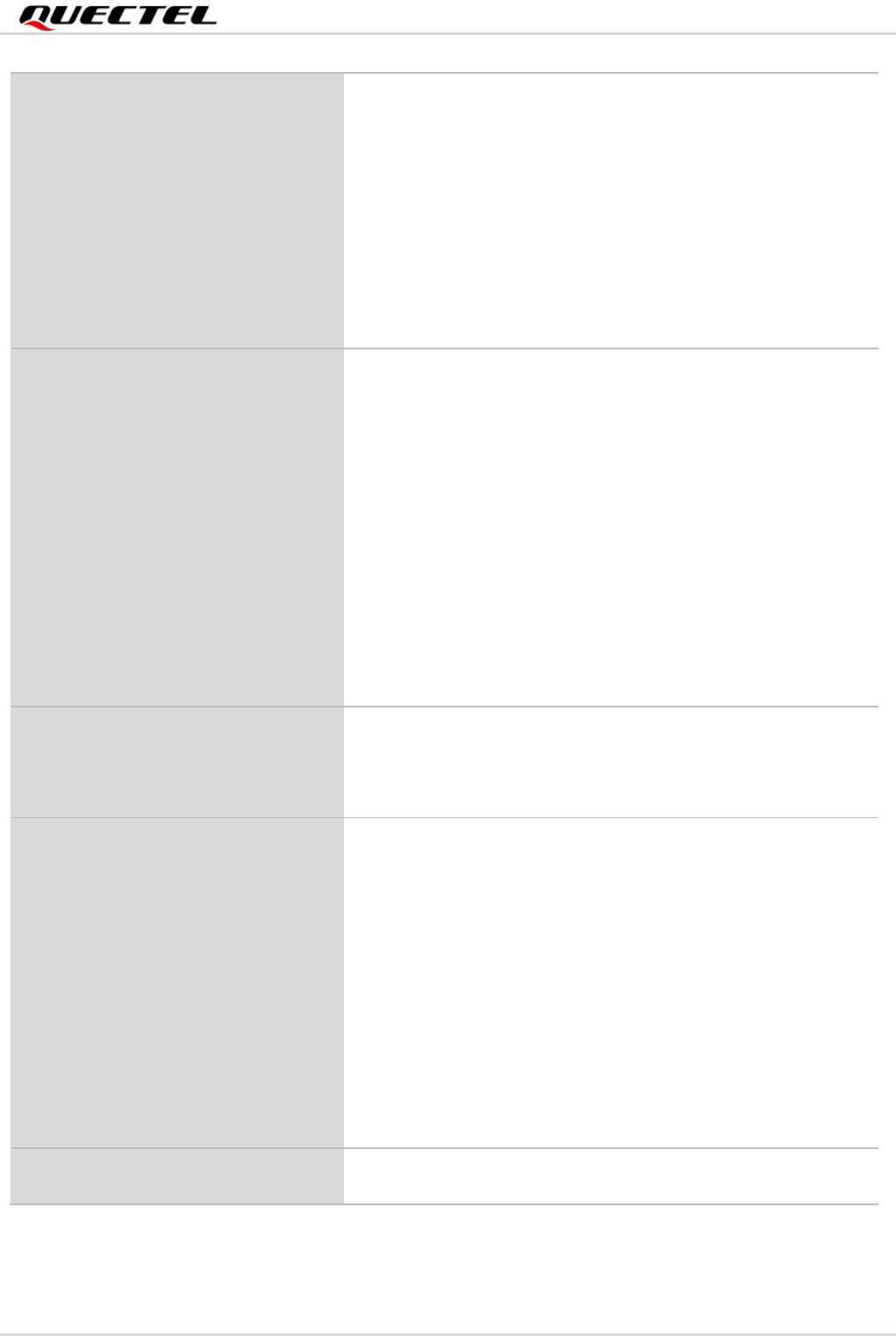
LTE Standard Module Series
EC200U&EG915U_Series_HTTP(S)_Application_Note 14 / 50
Write Command
AT+QHTTPCFG="auth"[,<user_pwd
>]
Response
If the optional parameter is omitted, query the current settings:
+QHTTPCFG: "auth",<user_pwd>
OK
If the optional parameter is specified:
OK
Or
+CME ERROR: <err>
Write Command
AT+QHTTPCFG="form/data"[,<nam
e>[,<file_name>[,<content_type>]]]
Response
If the optional parameters are omitted, query the current
settings:
+QHTTPCFG: "form/data",<name>,<file_name>,<content_t
ype>
[…]
OK
If any of the optional parameters is specified:
OK
Or
+CME ERROR: <err>
Write Command
AT+QHTTPCFG="reset"
Response
OK
Or
+CME ERROR: <err>
Read Command
AT+QHTTPCFG?
Response
+QHTTPCFG: "contextid",<contextID>
+QHTTPCFG: "requestheader",<request_header>
+QHTTPCFG: "responseheader",<response_header>
+QHTTPCFG: "sslctxid",<sslctxID>
+QHTTPCFG: "contenttype",<content_type>
+QHTTPCFG: "rspout/auto",<auto_outrsp>
+QHTTPCFG: "closed/ind",<closedind>
+QHTTPCFG: "url",<url_value>
+QHTTPCFG: "auth",<user_pwd>
OK
Characteristics Description
The command takes effect immediately.
The configurations will not be saved.

LTE Standard Module Series
EC200U&EG915U_Series_HTTP(S)_Application_Note 15 / 50
Parameter
2.3.2. AT+QHTTPURL Set URL of HTTP(S) Server
URL must begin with http:// or https://, which indicates the access to an HTTP or HTTPS server.
<contextID> Integer type. PDP context ID. Range: 1–7. Default: 1.
<request_header> Integer type. Disable or enable to customize HTTP(S) request header.
0 Disable
1 Enable
<response_header> Integer type. Disable or enable to output HTTP(S) response header.
0 Disable
1 Enable
<sslctxID> Integer type. SSL context ID used for HTTP(S). Range: 0–5. Default: 1. SSL
parameters should be configured by AT+QSSLCFG. For details, See
document [2].
<content_type> Integer type. Data type of HTTP(S) body.
0 application/x-www-form-urlencoded
1 text/plain
2 application/octet-stream
3 multipart/form-data
<auto_outrsp> Integer type. Disable or enable auto output of HTTP(S) response data. If auto
output of HTTP(S) response data is enabled, then AT+QHTTPREAD and
AT+QHTTPREADFILE will fail to execute.
0 Disable
1 Enable
<closedind> Integer type. Disable or enable report indication of closed HTTP(S) session.
0 Disable
1 Enable
<url_value> String type. The URL of HTTP(S).
<header_value> String type. HTTP(S) request header line/header field name, such as:
"Content-type: text/plain" or "Content-type"
<user_pwd> String type. User name and password, the format is: "username:password"
<name> String type. The name value of form-data.
<file_name> String type. The filename value of form-data.
<content_type> String type. The content-type value of form-data.
<err> The error code of the operation. See Chapter 5.
AT+QHTTPURL Set URL of HTTP(S) Server
Test Command
AT+QHTTPURL=?
Response
+QHTTPURL: (range of supported <URL_length>s),(range
of supported <timeout>s)
OK
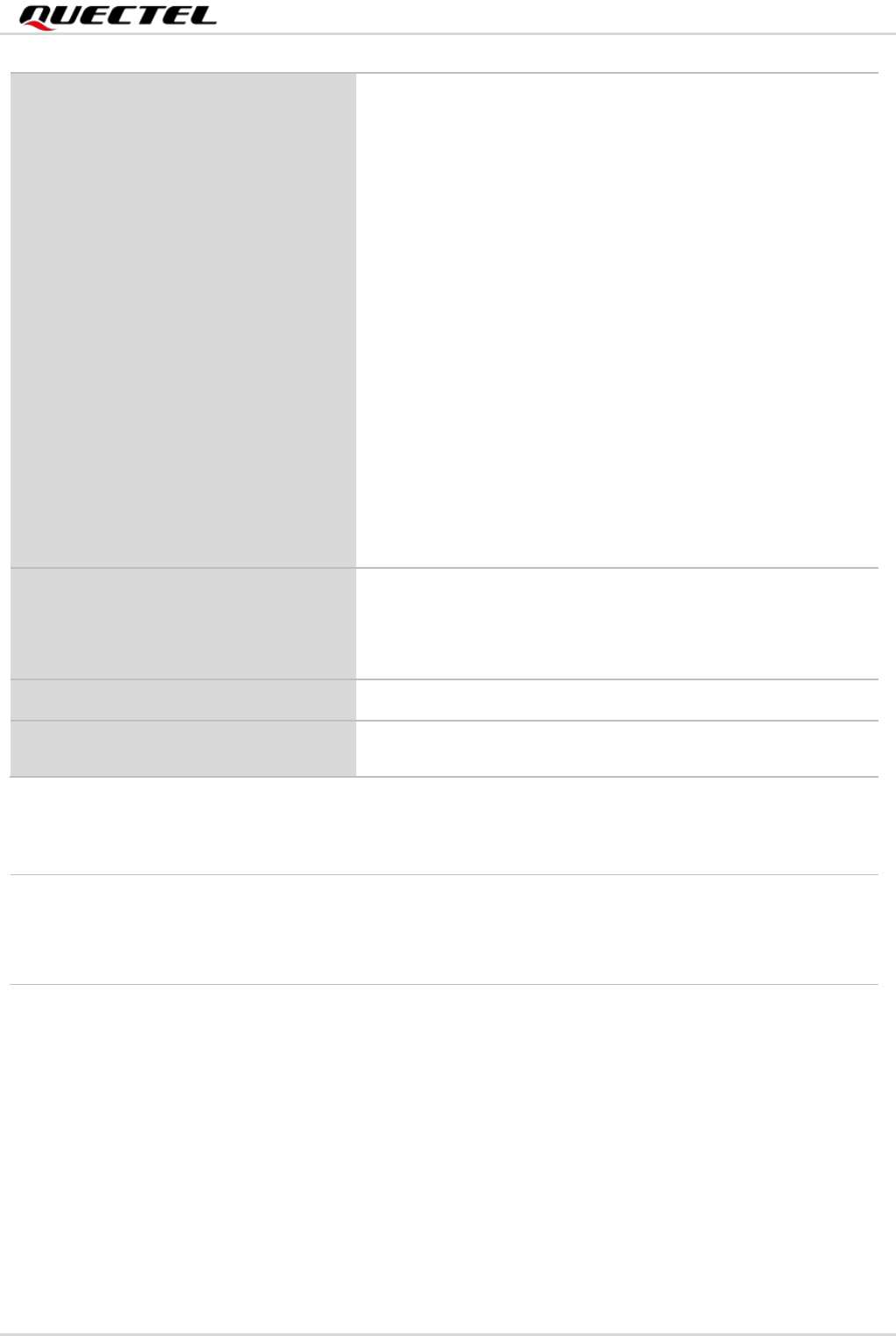
LTE Standard Module Series
EC200U&EG915U_Series_HTTP(S)_Application_Note 16 / 50
Parameter
<URL_length> Integer type. The length of URL. Range: 7–65535. Unit: byte.
<timeout> Integer type. The maximum time for inputting URL. Range: 1–65535. Default: 60.
Unit: second.
<err> The error code of the operation. See Chapter 5.
2.3.3. AT+QHTTPGET Send GET Request to HTTP(S) Server
According to the configured <request_header> parameter in AT+QHTTPCFG="requestheader"[,
<request_header>], AT+QHTTPGET Write Command has two different formats. If <request_header> is
set to 1, after AT+QHTTPGET has been sent, CONNECT may be outputted in 125 s to indicate that the
HTTP(S) is connected successfully. If it is not outputted during the time, then +CME ERROR: <err> will
be outputted.
Write Command
AT+QHTTPURL=<URL_length>[,<tim
eout>]
Response
If the parameter format is correct, and HTTP(S) GET/POST
requests are not be sent:
CONNECT
TA switches to transparent access mode, and the URL can be
inputted. When the total size of the inputted data reaches
<URL_length>, TA will return to command mode and report
the following code:
OK
If the <timeout> has reached, but the received length of URL
is less than <URL_length>, TA will return to command mode
and report the following code:
+CME ERROR: <err>
If the parameter format is incorrect or other errors occur:
+CME ERROR: <err>
Read Command
AT+QHTTPURL?
Response
[+QHTTPURL: <URL>]
OK
Maximum Response Time
Determined by <timeout>
Characteristics Description
The command takes effect immediately.
The configurations will not be saved.
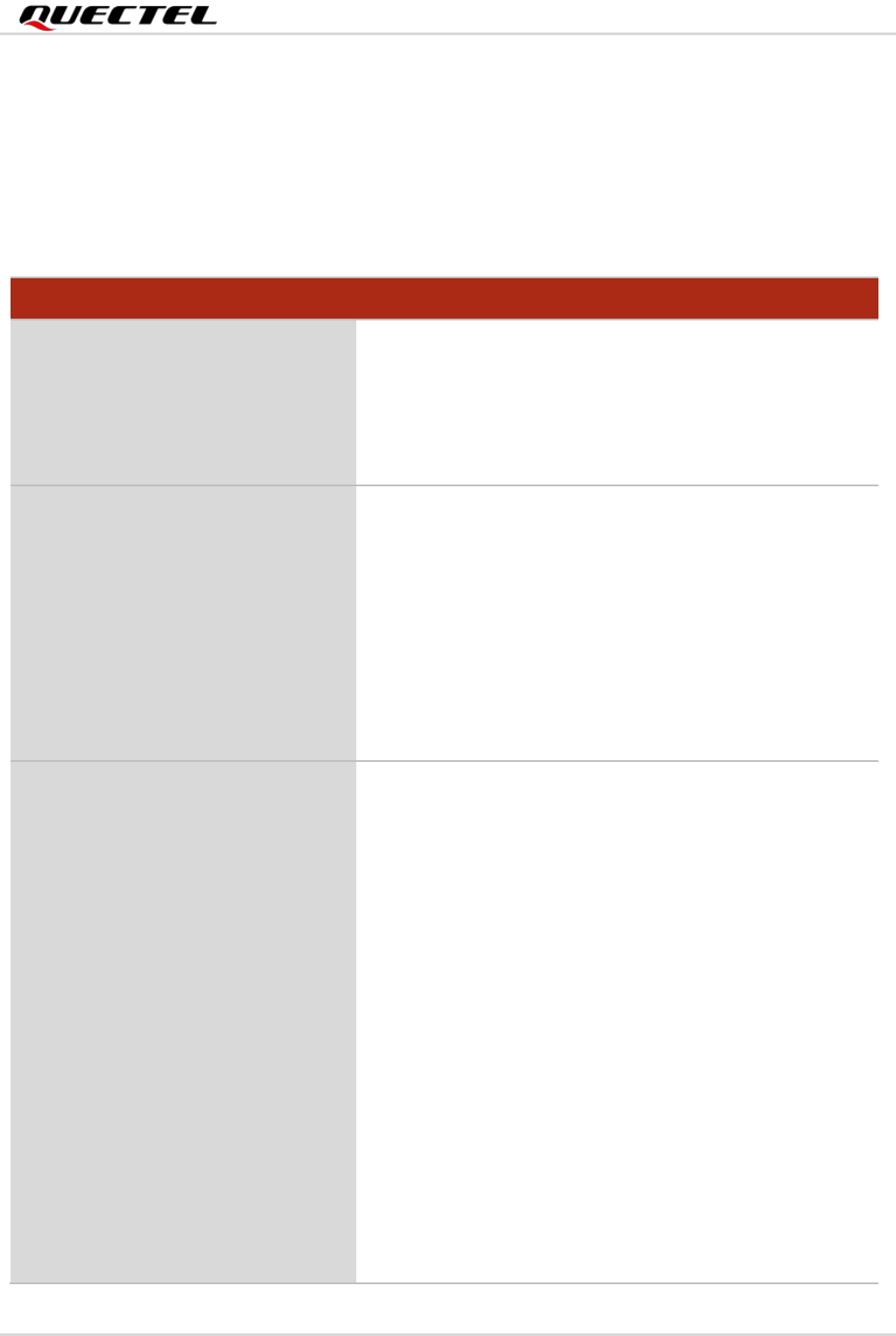
LTE Standard Module Series
EC200U&EG915U_Series_HTTP(S)_Application_Note 17 / 50
After AT+QHTTPGET Write Command has been sent, it is recommended to wait for a specific period of
time (see the maximum response time below) for URC +QHTTPGET:
<err>,<httprspcode>[,<content_length>] to be outputted after OK is reported.
In +QHTTPGET: <err>,<httprspcode>[,<content_length>], the <httprspcode> parameter can only be
reported when <err> equals 0. If HTTP(S) response header contains Content-Length information, then
<content_length> information will be reported.
AT+QHTTPGET Send GET Request to HTTP(S) Server
Test Command
AT+QHTTPGET=?
Response
+QHTTPGET: (range of supported <rsptime>s),(range of
supported <data_length>s),(range of supported <input_ti
me>s)
OK
Write Command
If <request_header> equals 0 (disable
to customize HTTP(S) request header)
AT+QHTTPGET[=<rsptime>]
Response
If the parameter format is correct and no other errors occur:
OK
When the module has received response from HTTP(S)
server, it will report the following URC:
+QHTTPGET: <err>,<httprspcode>[,<content_length>]
If the parameter format is incorrect or other errors occur:
+CME ERROR: <err>
Write Command
If <request_header> equals 1 (enable
to customize HTTP(S) GET request
header)
AT+QHTTPGET=<rsptime>,<data_len
gth>[,<input_time>]
Response
If HTTP(S) server is connected successfully:
CONNECT
TA switches to transparent access mode, and the HTTP(S)
GET request header can be inputted. When the total size of
the inputted data reaches <data_length>, TA will return to
command mode and report the following code:
OK
When the module has received response from HTTP(S)
server, it will report the following URC:
+QHTTPGET: <err>,<httprspcode>[,<content_length>]
If the <input_time> has reached, but the length of received
data is less than <data_length>, TA will return to command
mode and report the following code:
+QHTTPGET: <err>
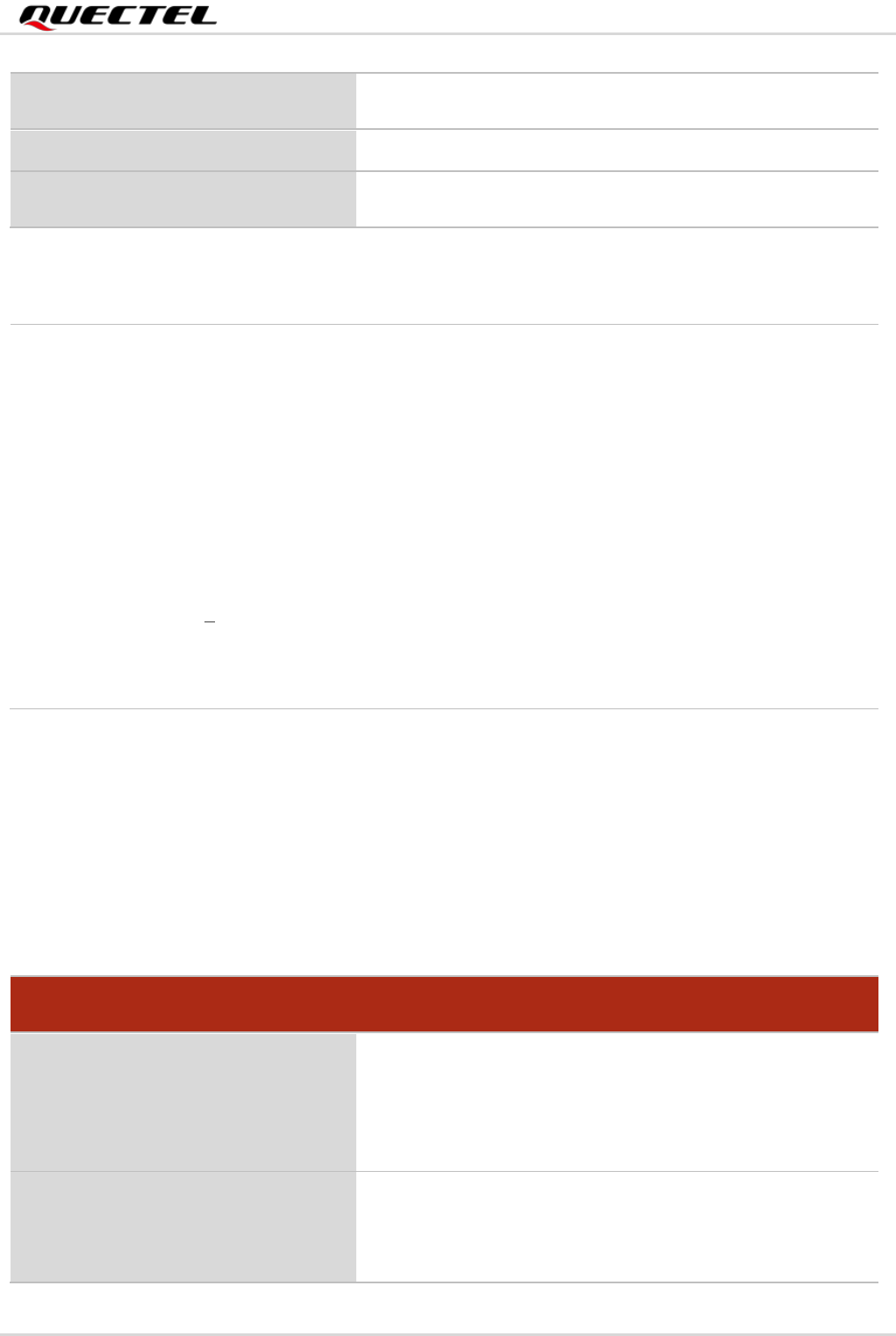
LTE Standard Module Series
EC200U&EG915U_Series_HTTP(S)_Application_Note 18 / 50
Parameter
<rsptime> Integer type. Range: 1–65535. Default: 60. Unit: second. It is used to configure
the timeout for the HTTP(S) GET response +QHTTPGET:
<err>,<httprspcode>[,<content_length>] to be outputted after OK is returned.
<data_length> Integer type. The length of HTTP(S) request information, including HTTP(S)
request header and HTTP(S) request body. Range: 1–65535. Unit: byte.
<input_time> Integer type. The maximum time for inputting HTTP(S) request
information, including HTTP(S) request header and HTTP(S) request body.
Range: 1–65535. Default: 60. Unit: second.
<httprspcode> Http response code. See Chapter 6 for details.
<request_header> Integer type. Disable or enable to customize HTTP(S) request header.
0 Disable
1 Enable
<content_length> Integer type. The length of HTTP(S) response body. Unit: byte.
<err> The error code of the operation. See Chapter 5.
2.3.4. AT+QHTTPGETEX Send GET Request to HTTP(S) Server to Get Data with
Specified Range
Like the way of reading files, MCU can get data from HTTP(S) server with specified position and specified
length by AT+QHTTPGETEX, and this command is only executable in the condition of
AT+QHTTPCFG="requestheader",0. After that, HTTP(S) server will always respond to the GET request
that is used to get data with specified position and length with 206 code.
If the parameter format is incorrect or other errors occur:
+CME ERROR: <err>
Maximum Response Time
Determined by <rsptime>
Characteristics Description
The command takes effect immediately.
The configurations will not be saved.
AT+QHTTPGETEX Send GET Request to HTTP(S) Server to Get Data with Specified
Range
Test Command
AT+QHTTPGETEX=?
Response
+QHTTPGET: (range of supported <rsptime>s),<start_po
stion>,<read_len>
OK
Write Command
AT+QHTTPGETEX=<rsptime>,<start_
position>,<read_len>
Response
a) If the parameter format is correct and no other errors occur:
OK

LTE Standard Module Series
EC200U&EG915U_Series_HTTP(S)_Application_Note 19 / 50
Parameter
<rsptime> Integer type. Range: 1–65535. Default: 60. Unit: second. It is used to configure
the timeout for the HTTP(S) GET response +QHTTPGET:
<err>,<httprspcode>[,<content_length>] to be outputted after OK is returned.
<start_postion > Integer type. The start position of the data that the HTTP(S) client wants to get.
<read_len> Integer type. The length of the data that the HTTP(S) client wants to get.
<httprspcode> HTTP response code. See Chapter 6 for details.
<content_length> Integer type. The length of HTTP(S) response body. Unit: byte.
<err> The error code of the operation. See Chapter 5.
2.3.5. AT+QHTTPPOST Send POST Request to HTTP(S) Server via UART/USB
The command sends HTTP(S) POST request via UART/USB. According to the configured
<request_header> parameter in AT+QHTTPCFG="requestheader"[,<request_header>], the
AT+QHTTPPOST Write Command has two different formats. If <request_header> is set to 0, HTTP(S)
POST body should be inputted via UART/USB port. If <request_header> is set to 1, then both HTTP(S)
POST header and body should be inputted via UART/USB port.
After AT+QHTTPPOST has been sent, CONNECT may be outputted in 125 s to indicate the connection is
successful. If it is not received during the time, +CME ERROR: <err> will be outputted.
It is recommended to wait for a specific period of time (see the maximum response time below) for
+QHTTPPOST: <err>,<httprspcode>[,<content_length>] to be outputted after OK is reported.
When the module has received response from HTTP(S)
server, it will report the following URC:
+QHTTPGET: <err>,<httprspcode>[,<content_length>]
b) If the parameter format is incorrect or other errors occur:
+CME ERROR: <err>
Maximum Response Time
Determined by <rsptime>
Characteristics Description
The command takes effect immediately.
The configurations will not be saved.
AT+QHTTPPOST Send POST Request to HTTP(S) Server via UART/USB
Test Command
AT+QHTTPPOST=?
Response
+QHTTPPOST: (range of supported <data_length>s),(range
of supported <input_time>s),(range of supported
<rsptime>s)
OK

LTE Standard Module Series
EC200U&EG915U_Series_HTTP(S)_Application_Note 20 / 50
Write Command
If <request_header> equals 0 (disable
to customize HTTP(S) request header)
AT+QHTTPPOST=<data_length>[,<in
put_time>,<rsptime>]
Response
If the parameter format is correct and HTTP(S) server is
connected successfully and HTTP(S) request header is sent
completely, it will prompt to input body:
CONNECT
TA switches to transparent access mode, and the HTTP(S)
POST body can be inputted. When the total size of the
inputted data reaches <data_length>, TA will return to
command mode and report the following code:
OK
When the module has received response from HTTP(S)
server, it will report the following URC:
+QHTTPPOST: <err>,<httprspcode>[,<content_length>]
If the <input_time> has reached, but the received length of
data is less than <data_length>, TA will return to command
mode and report the following code:
+QHTTPPOST: <err>
If the parameter format is incorrect or other errors occur:
+CME ERROR: <err>
Write Command
If <request_header> equals 1 (enable
to customize HTTP(S) request header)
AT+QHTTPPOST=<data_length>[,<in
put_time>,<rsptime>]
Response
If the parameter format is correct and HTTP(S) server is
connected successfully:
CONNECT
TA switches to the transparent access mode, and the
HTTP(S) POST header and body can be inputted. When the
total size of the inputted data reaches <data_length>, TA will
return to command mode and report the following code:
OK
When the module has received response from HTTP(S)
server, it will report the following URC:
+QHTTPPOST: <err>,<httprspcode>[,<content_length>]
If the <input_time> has reached, but the length of received
data is less than <data_length>, TA will return to command
mode and report the following code:
+QHTTPPOST: <err>
If the parameter format is incorrect or other errors occur:
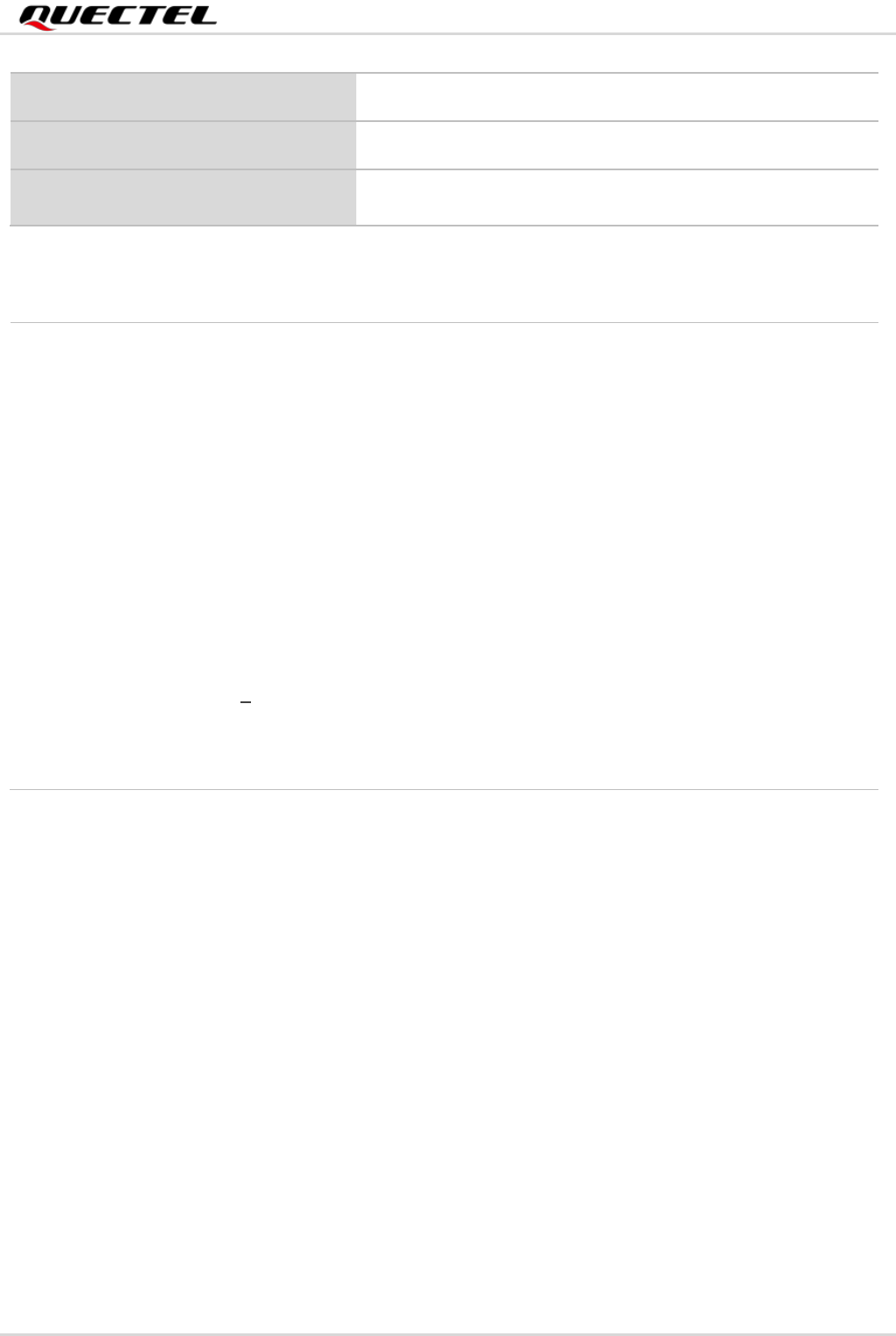
LTE Standard Module Series
EC200U&EG915U_Series_HTTP(S)_Application_Note 21 / 50
Parameter
<data_length> Integer type. If <request_header> is 0, it indicates the length of HTTP(S)
POST body. If <request_header> is 1, it indicates the length of HTTP(S)
POST request information, including HTTP(S) POST request header and
body. Range: 1–1024000. Unit: byte.
<input_time> Integer type. The maximum time for inputting HTTP(S) POST body or
HTTP(S) POST request information. Range: 1–65535. Default: 60. Unit:
second.
<rsptime> Integer type. Range: 1–65535. Default: 60. Unit: second. It is used to
configure the timeout for the HTTP(S) POST response +QHTTPPOST:
<err>,<httprspcode>[,<content_length>] to be outputted after OK is
returned.
<httprspcode> Http response code. See Chapter 6 for details.
<request_header> Integer type. Disable or enable to customize HTTP(S) request header.
0 Disable
1 Enable
<content_length> Integer type. The length of HTTP(S) response body. Unit: byte.
<err> The error code of the operation. See Chapter 5.
2.3.6. AT+QHTTPPOSTFILE Send POST Request to HTTP(S) Server via File
The command sends HTTP(S) POST request via file. According to the <request_header> in
AT+QHTTPCFG="requestheader"[,<request_header>], the file operated by AT+QHTTPPOSTFILE
has two different formats. If <request_header> is set to 0, the file in file system will be HTTP(S) POST
body. If <request_header> is set to 1, the file in file system will be HTTP(S) POST header and body.
The module will report +QHTTPPOSTFILE: <err>,<httprspcode>[,<content_length>] information to
indicate the executing result of AT+QHTTPPOSTFILE. The <httprspcode> parameter can only be
reported when <err> equals 0.
It is recommended to wait for a specific period of time (see the maximum response time below) for
+QHTTPPOSTFILE: <err>,<httprspcode>[,<content_length>] to be outputted after OK is reported.
+CME ERROR: <err>
Maximum Response Time
Determined by network and <rsptime>
Characteristics Description
The command takes effect immediately.
The configurations will not be saved.
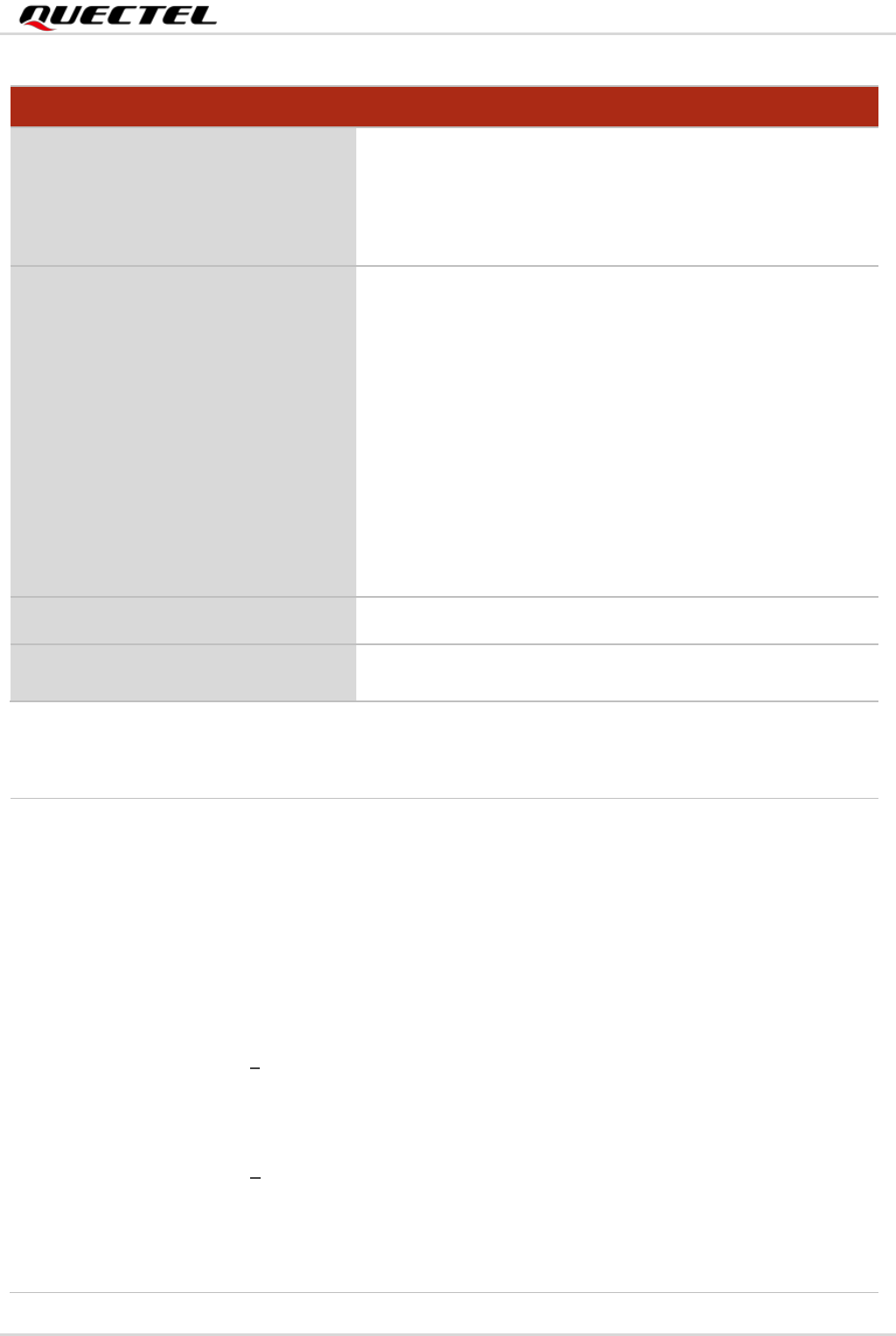
LTE Standard Module Series
EC200U&EG915U_Series_HTTP(S)_Application_Note 22 / 50
Parameter
<file_name> String type. File name. The max length of file name is 132 bytes.
<rsptime> Integer type. Range: 1–65535. Default: 60. Unit: second. It is used to
configure the timeout for the HTTP(S) POST response +QHTTPPOSTFILE:
<err>,<httprspcode>[,<content_length>] to be outputted after OK is
returned.
<httprspcode> HTTP response code. See Chapter 6 for details.
<request_header> Integer type. Disable or enable to customize HTTP(S) request header. If
<request_header> equals 1, the specified file must contain HTTP(S)
request header information.
0 Disable
1 Enable
<content_length> Integer type. The length of HTTP(S) response body. Unit: byte.
<post_mode> String type. HTTP(S) sending files in segments.
0 Send the current file directly
1 Record the file name to be sent (not send the file currently, waiting to be
sent with the file configured when <post_mode>=2.
2 Send the files configured when <post_mode>=1 and 2 in order (only
support two files sent together)
AT+QHTTPPOSTFILE Send POST Request to HTTP(S) Server via File
Test Command
AT+QHTTPPOSTFILE=?
Response
+QHTTPPOSTFILE: <file_name>,(range of supported
<rsptime>s)[,(range of supported <post_mode>s)]
OK
Write Command
AT+QHTTPPOSTFILE=<file_name>[,<
rsptime>,<post_mode>]
Response
If parameter format is correct and HTTP(S) server is
connected successfully:
OK
When the module has received response from HTTP(S)
server, it will report the following URC:
+QHTTPPOSTFILE:
<err>,<httprspcode>[,<content_length>]
If parameter format is incorrect or other errors occur:
+CME ERROR: <err>
Maximum Response Time
Determined by <rsptime>
Characteristics Description
The command takes effect immediately.
The configurations will not be saved.
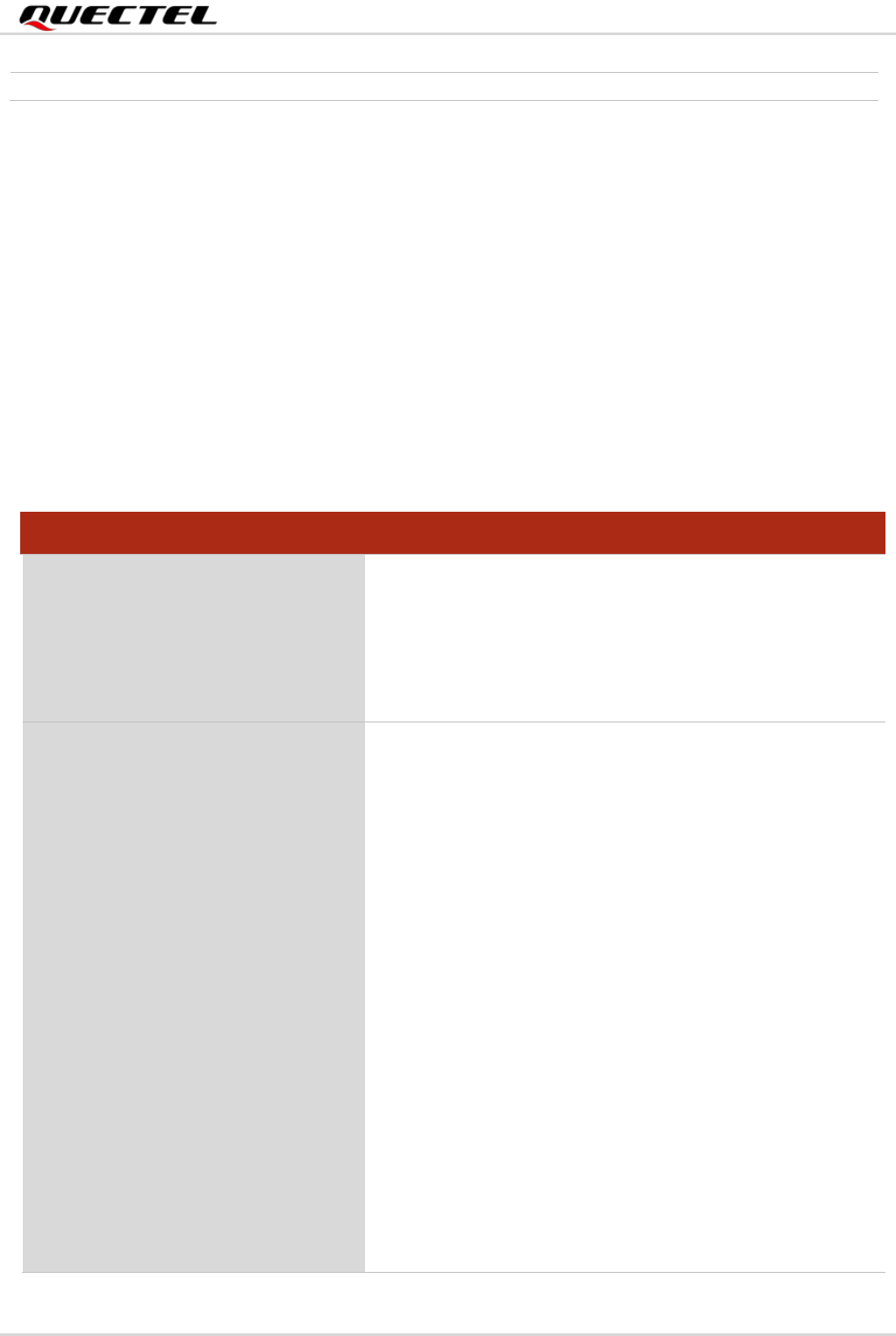
LTE Standard Module Series
EC200U&EG915U_Series_HTTP(S)_Application_Note 23 / 50
<err> The error code of the operation. See Chapter 5.
2.3.7. AT+QHTTPPUT Send PUT Request to HTTP(S) Server via UART/USB
This command sends HTTP(S) PUT request via UART/USB. According to the configured
<request_header> parameter in AT+QHTTPCFG="requestheader"[,<request_header>] command,
the AT+QHTTPPUT Write Command has two different formats. If <request_header> is set to 0, HTTP(S)
PUT body should be inputted via UART/USB port. If <request_header> is set to 1, then both HTTP(S)
PUT header and body should be inputted via UART/USB port.
After AT+QHTTPPUT command has been sent, CONNECT may be outputted in 125 s to indicate the
connection is successful. Otherwise, +CME ERROR: <err> will be outputted.
It is recommended to wait for a specific period of time (see the maximum response time below) for
+QHTTPPUT: <err>,<httprspcode>[,<content_length>] to be outputted after OK is reported.
AT+QHTTPPUT Send PUT Request to HTTP(S) Server via UART/USB
Test Command
AT+QHTTPPUT=?
Response
+QHTTPPUT: (range of supported <data_length>s),(range
of supported <input_time>s),(range of supported
<rsptime>s)
OK
If <request_header> equals 0 (disable
to customize HTTP(S) request header)
Write Command
AT+QHTTPPUT=<data_length>[,<in
put_time>,<rsptime>]
Response
If the parameter format is correct and HTTP(S) server is
connected successfully and HTTP(S) request header is sent
completely:
CONNECT
TA switches to transparent access mode, and the HTTP(S)
PUT body can be inputted. When the total size of the inputted
data reaches <data_length>, TA will return to command
mode and report the following code:
OK
When the module has received response from HTTP(S)
server, it will report the following URC:
+QHTTPPUT: <err>,<httprspcode>[,<content_length>]
If the <input_time> has reached, but the received length of
data is less than <data_length>, TA will return to command
mode and report the following code:
+QHTTPPUT: <err>
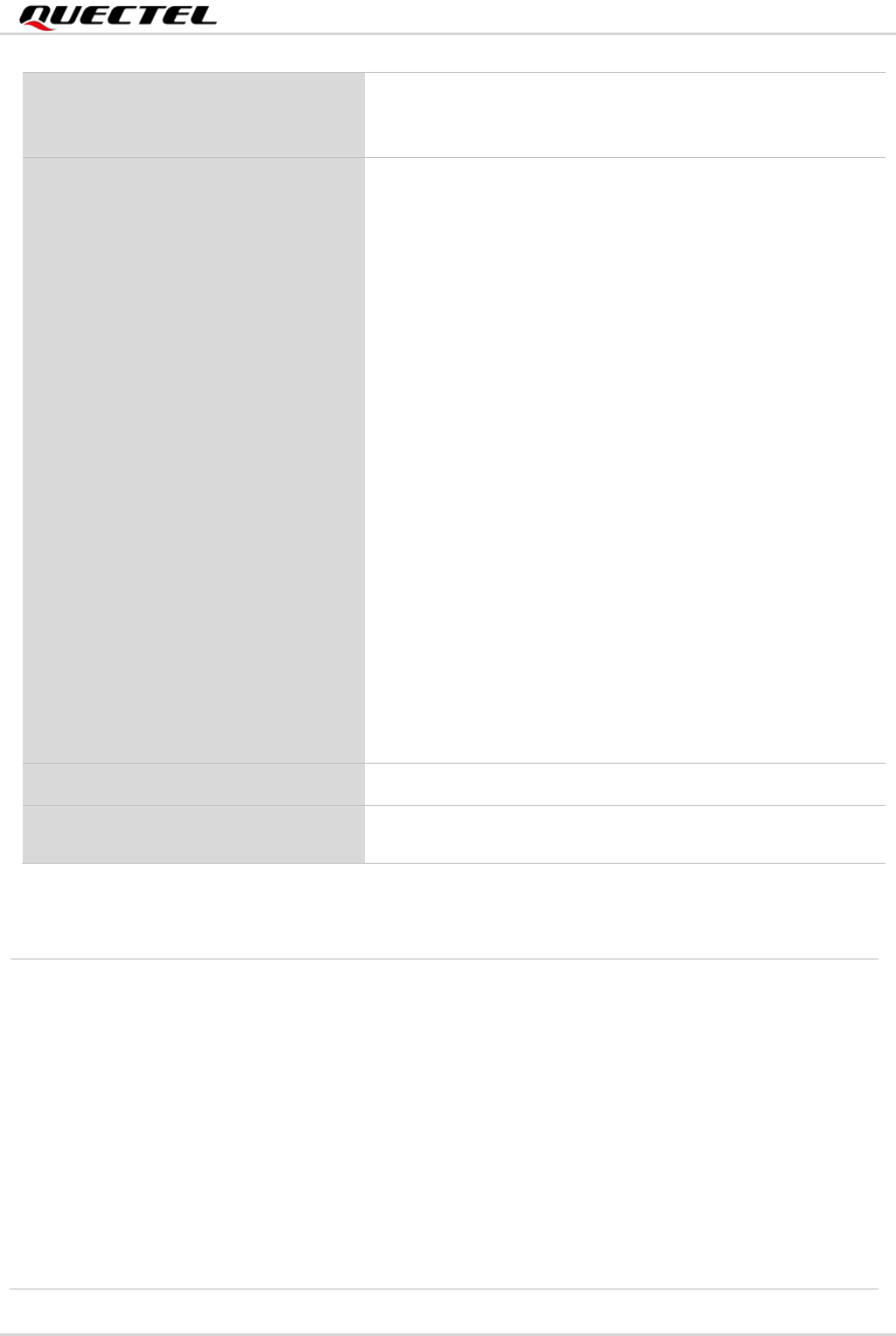
LTE Standard Module Series
EC200U&EG915U_Series_HTTP(S)_Application_Note 24 / 50
Parameter
If the parameter format is incorrect or other errors occur:
+CME ERROR: <err>
If <request_header> equals 1 (enable
to customize HTTP(S) request header)
Write Command
AT+QHTTPPUT=<data_length>[,<in
put_time>,<rsptime>]
Response
If the parameter format is correct and HTTP(S) server is
connected successfully:
CONNECT
TA switches to the transparent access mode, and the
HTTP(S) PUT header and body can be inputted. When the
total size of the inputted data reaches <data_length>, TA will
return to command mode and report the following code:
OK
When the module has received response from HTTP(S)
server, it will report the following URC:
+QHTTPPUT: <err>,<httprspcode>[,<content_length>]
If the <input_time> has reached, but the length of received
data is less than <data_length>, TA will return to command
mode and report the following code:
+QHTTPPUT: <err>
If the parameter format is incorrect or other errors occur:
+CME ERROR: <err>
Maximum Response Time
Determined by network and <rsptime>
Characteristics
The command takes effect immediately.
The configurations will not be saved.
<data_length> Integer type. If <request_header> is 0, it indicates the length of HTTP(S)
PUT body. If <request_header> is 1, it indicates the length of HTTP(S) PUT
request information, including HTTP(S) PUT request header and body.
Range: 1–1024000. Unit: byte.
<input_time> Integer type. The maximum time for inputting HTTP(S) PUT body or HTTP(S)
PUT request information. Range: 1–65535. Default value: 60. Unit: second.
<rsptime> Integer type. Range: 1–65535. Default value: 60. Unit: second. It is used to
configure the timeout for the HTTP(S) PUT response +QHTTPPOST:
<err>,<httprspcode>[,<content_length>] to be outputted after OK is
returned.
<httprspcode> HTTP server response code. See Chapter 6.
<request_header> Integer type. Disable or enable to customize HTTP(S) request header.

LTE Standard Module Series
EC200U&EG915U_Series_HTTP(S)_Application_Note 25 / 50
2.3.8. AT+QHTTPPUTFILE Send PUT Request to HTTP(S) Server via File
This command sends HTTP(S) PUT request via file. According to the <request_header> in
AT+QHTTPCFG="requestheader"[,<request_header>] command, the file operated by
AT+QHTTPPUTFILE command has two different formats. If <request_header> is set to 0, the file in file
system will be HTTP(S) PUT body. If <request_header> is set to 1, the file in file system will be HTTP(S)
PUT header and body.
After executing AT+QHTTPPUTFILE, the module will report +QHTTPPUTFILE:
<err>,<httprspcode>[,<content_length>] information to indicate the execution result. The
<httprspcode> parameter can only be reported when <err> equals 0.
It is recommended to wait for a specific period of time (see the maximum response time below) for
+QHTTPPUTFILE: <err>,<httprspcode>[,<content_length>] to be outputted after OK is reported.
0 Disable
1 Enable
<content_length> Integer type. The length of HTTP(S) response body. Unit: byte.
<err> The error code of the operation. See Chapter 5.
AT+QHTTPPUTFILE Send PUT Request to HTTP(S) Server via File
Test Command
AT+QHTTPPUTFILE=?
Response
+QHTTPPUTFILE: <file_name>,(range of supported
<rsptime>s)[,(range of supported <put_mode>s)]
OK
Write Command
AT+QHTTPPOSTFILE=<file_name>,<
rsptime>[,<put_mode>]
Response
If parameter format is correct and HTTP(S) server is
connected successfully:
OK
When the module has received response from HTTP(S)
server, it will report the following URC:
+QHTTPPUTFILE: <err>,<httprspcode>[,<content_lengt
h>]
If parameter format is incorrect or other errors occur:
+CME ERROR: <err>
Maximum Response Time
Determined by network and <rsptime>
Characteristics
The command takes effect immediately.
The configurations will not be saved.

LTE Standard Module Series
EC200U&EG915U_Series_HTTP(S)_Application_Note 26 / 50
Parameter
<file_name> String type. File name. The max length of file name is 132 bytes.
<rsptime> Integer type. Range: 1–65535. Default: 60. Unit: second. It is used to
configure the timeout for the HTTP(S) POST response
+QHTTPPOSTFILE: <err>[,<httprspcode>,<content_length>] to be
outputted after OK is returned.
<httprspcode> HTTP server response code. See Chapter 6.
<request_header> Integer type. Disable or enable to customize HTTP(S) request header. If
<request_header> equals 1, the specified file must contain HTTP(S)
request header information.
0 Disable
1 Enable
<content_length> Integer type. The length of HTTP(S) response body. Unit: byte.
<put_mode> Integer type. The mode of HTTP(S) sending files.
0 Send file content directly
1 Record and save the file, do not send it temporarily, wait to send it
with the file configured when <put_mode>=2
2 Send the file, together with the file saved when <put_mode>=1
(only support two files sent together)
<err> The error code of the operation. See Chapter 5.
2.3.9. AT+QHTTPREAD Read Response from HTTP(S) Server via UART/USB
After sending HTTP(S) GET/POST requests, HTTP(S) response information can be retrieved from
HTTP(S) server via UART/USB port by AT+QHTTPREAD. And +QHTTPGET:
<err>,<httprspcode>[,<content_length>], +QHTTPPOST: <err>,<httprspcode>[,<content_length>]
or +QHTTPPOSTFILE: <err>,<httprspcode>[,<content_length>] information must be received before
executing AT+QHTTPREAD.
AT+QHTTPREAD Read Response from HTTP(S) Server via UART/USB
Test Command
AT+QHTTPREAD=?
Response
+QHTTPREAD: (range of supported <wait_time>s)
OK
Write Command
AT+QHTTPREAD[=<wait_time>]
Response
a) If the parameter format is correct and read successfully:
CONNECT
<Output HTTP(S) response information>
OK
When body is read over or <wait_time> reaches, it will report:
+QHTTPREAD: <err>
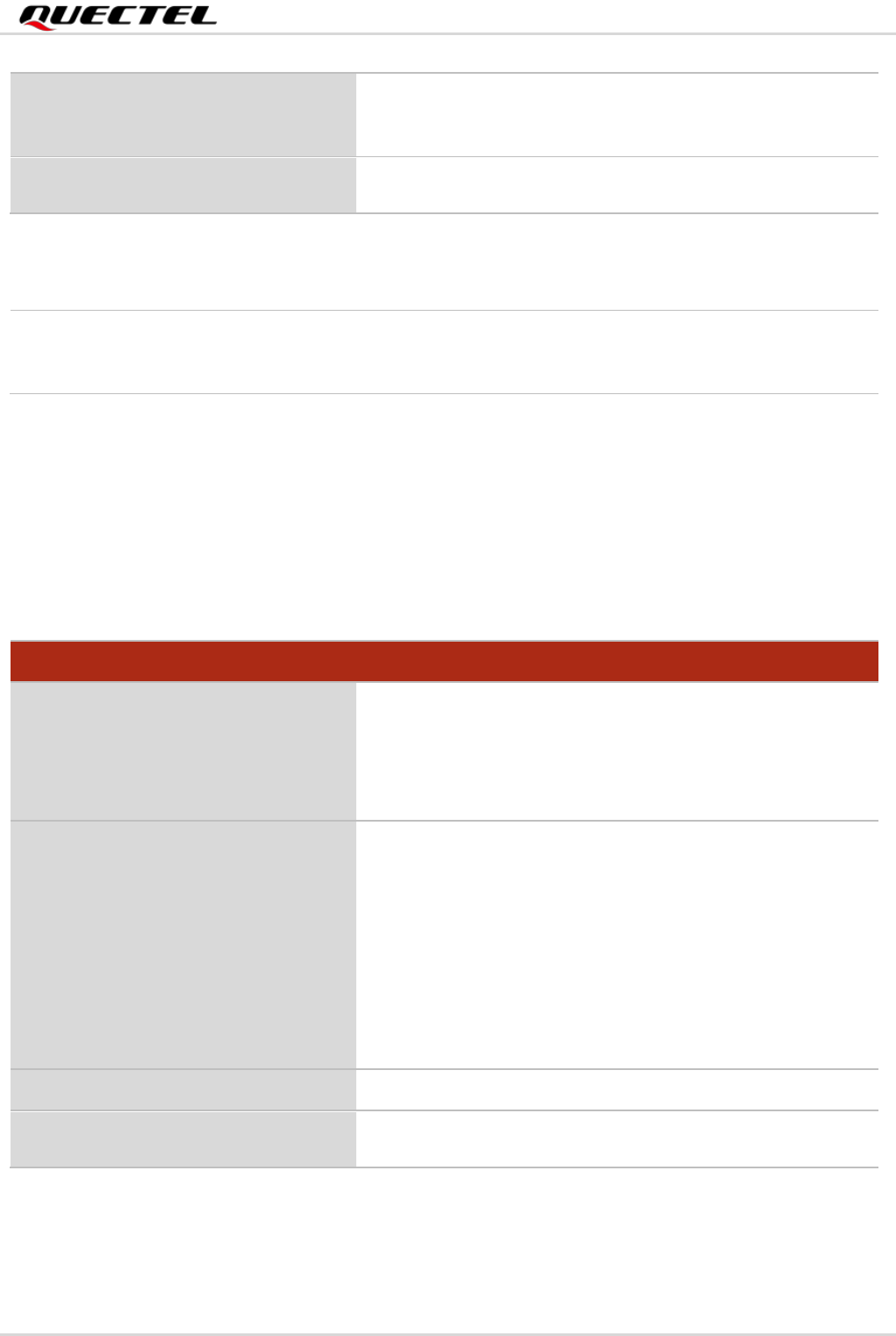
LTE Standard Module Series
EC200U&EG915U_Series_HTTP(S)_Application_Note 27 / 50
Parameter
<wait_time> Integer type. The maximum interval time between receiving two packets of data.
Range: 1–65535. Default: 60. Unit: second.
<err> The error code of the operation. See Chapter 5.
2.3.10. AT+QHTTPREADFILE Read Response from HTTP(S) Server via File
After sending HTTP(S) GET/POST requests, HTTP(S) response information can be retrieved from
HTTP(S) server via file by AT+QHTTPREADFILE. And +QHTTPGET: <err>,<httprspcode>[,<cont
ent_length>], +QHTTPPOST: <err>,<httprspcode>[,<content_length>] or +QHTTPPOSTFILE: <er
r>,<httprspcode>[,<content_length>] information must be received before executing AT+QHTTPR
EADFILE.
b) If the parameter format is incorrect or other errors occur:
+CME ERROR: <err>
Characteristics Description
The command takes effect immediately.
The configurations will not be saved.
AT+QHTTPREADFILE Read Response from HTTP(S) Server via File
Test Command
AT+QHTTPREADFILE=?
Response
+QHTTPREADFILE: <file_name>,(range of supported
<wait_time>s)
OK
Write Command
AT+QHTTPREADFILE=<file_name>[,
<wait_time>]
Response
If the parameter format is correct:
OK
When body is read over or <wait_time> reaches, it will report:
+QHTTPREADFILE: <err>
If the parameter format is incorrect or other errors occur:
+CME ERROR: <err>
Maximum Response Time
Determined by <wait_time>
Characteristics Description
The command takes effect immediately.
The configurations will not be saved.
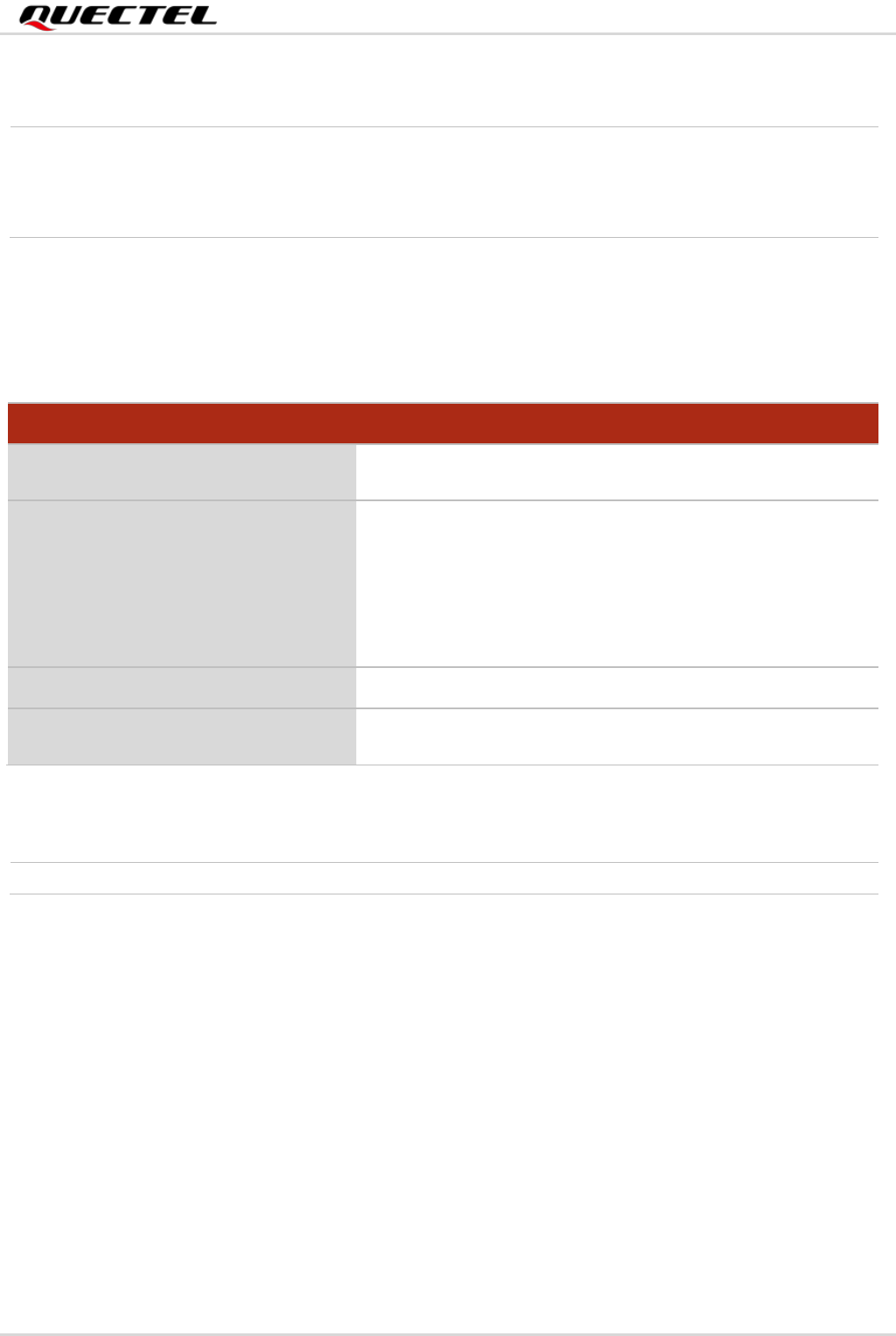
LTE Standard Module Series
EC200U&EG915U_Series_HTTP(S)_Application_Note 28 / 50
Parameter
<wait_time> Integer type. The maximum interval time between receiving two packets of
data. Range: 1–65535. Default: 60. Unit: second.
<file_name> String type. File name. The maximum length of the file name is 132 bytes.
<err> The error code of the operation. See Chapter 5.
2.3.11. AT+QHTTPSTOP Cancel HTTP(S) Request
MCU can cancel HTTP(S) GET/POST request, and disconnect session with HTTP(S) server via this
command.
Parameter
<err> The error code of the operation. See Chapter 5.
AT+QHTTPSTOP Cancel HTTP(S) Request
Test Command
AT+QHTTPSTOP=?
Response
OK
Execution Command
AT+QHTTPSTOP
Response
If the parameter format is correct and no other errors occur:
OK
If the parameter format is incorrect or other errors occur:
+CME ERROR: <err>
Maximum Response Time
10 s
Characteristics Description
The command takes effect immediately.
The configurations will not be saved.

LTE Standard Module Series
EC200U&EG915U_Series_HTTP(S)_Application_Note 29 / 50
3 Examples
3.1. Access to HTTP Server
3.1.1. Send HTTP GET Request and Read the Response
The following examples show how to send HTTP GET request and enable output of HTTP response
header, as well as how to read HTTP GET response.
//Example of how to send HTTP GET response.
AT+QHTTPCFG="contextid",1 //Configure the PDP context ID as 1.
OK
AT+QHTTPCFG="responseheader",1 //Allow to output HTTP response header.
OK //Only returning OK means that there is no activated PDP
context currently.
AT+QIACT? //Query the state of PDP context.
OK
AT+QICSGP=1,1,"UNINET","","",1 //Configure PDP context 1. APN is UNINET for China
Unicom.
OK
AT+QIACT=1 //Activate PDP context 1.
OK //Activated successfully.
AT+QIACT? //Query the state of PDP context.
+QIACT: 1,1,1,"10.7.157.1"
OK
AT+QHTTPURL=23,80 //Set the URL which will be accessed.
CONNECT
HTTP://www.sina.com.cn/ //Input URL whose length is 23 bytes. (This URL is only an
example. Please input the correct URL in practical test.)
OK
AT+QHTTPGET=80 //Send HTTP GET request and the maximum response time
is 80 s.
OK
+QHTTPGET: 0,200,601710 //If HTTP response header contains Content-Length
information, then the <content_length> information will be

LTE Standard Module Series
EC200U&EG915U_Series_HTTP(S)_Application_Note 30 / 50
reported.
//Example of how to read HTTP response.
//Solution 1: Read HTTP response information and output it via UART port.
AT+QHTTPREAD=80 //Read HTTP response information and output it via UART.
The maximum time to wait for HTTP session to be closed is
80 s.
CONNECT
HTTP/1.1 200 OK <CR><LF> //HTTP response header and body.
Server: nginx<CR><LF>
Date: Tue, 12 Sep 2017 05:57:29 GMT<CR><LF>
Content-Type: text/html<CR><LF>
Content-Length: 601710<CR><LF>
Connection: close<CR><LF>
Last-Modified: Tue, 12 Sep 2017 05:54:48 GMT<CR><LF>
Vary: Accept-Encoding<CR><LF>
Expires: Tue, 12 Sep 2017 05:58:28 GMT<CR><LF>
Cache-Control: max-age=60<CR><LF>
X-Powered-By: shci_v1.03<CR><LF>
Age: 1<CR><LF>
……<CR><LF> //Lines are omitted here.
<CR><LF>
<body>
OK
+QHTTPREAD: 0 //Read HTTP response header and body successfully.
//Solution 2: Read HTTP response information and store it to RAM file.
AT+QHTTPREADFILE="RAM:1.txt",80 //Read HTTP response header and body and store them to
RAM:1.txt. The maximum time to wait for HTTP session to
be closed is 80 s.
OK
+QHTTPREADFILE: 0 //HTTP response header and body are stored successfully.
3.1.2. Send HTTP POST Request and Read the Response
3.1.2.1. HTTP POST Body Obtained from UART/USB
The following examples show how to send HTTP POST request and retrieve HTTP POST body via UART
port, as well as how to read HTTP POST response.

LTE Standard Module Series
EC200U&EG915U_Series_HTTP(S)_Application_Note 31 / 50
AT+QHTTPCFG="contextid",1 //Configure the PDP context ID as 1.
OK
AT+QIACT? //Query the state of PDP context.
OK //Only returning OK means that there is no activated PDP
context currently.
AT+QICSGP=1,1,"UNINET","","",1 //Configure PDP context 1. APN is UNINET for China Unicom.
(Then set AT+CFUN=1,1 to make the configuration take effect.)
OK
AT+QIACT? //Query the state of context.
+QIACT: 1,1,1,"172.22.86.226"
OK
AT+QHTTPURL=59,80 //Set the URL which will be accessed and timeout value as 80 s.
CONNECT
http://api.efxnow.com/DEMOWebServices2.8/Service.asmx/Echo? //Input URL whose length is 59
bytes. (This URL is only an
example. Please input the
correct URL in practical test.)
OK
AT+QHTTPPOST=20,80,80 //Send HTTP POST request and HTTP POST body is obtained
via UART. The maximum input body time is 80 s and the
maximum response time is 80 s.
CONNECT
Message=HelloQuectel //Input HTTP POST body whose length is 20 bytes. (The POST body is
only an example. Please input the correct POST body in practical test.)
OK
+QHTTPPOST: 0,200,177 //If the HTTP response header contains Content-Length information,
the <content_length> information is reported.
AT+QHTTPREAD=80 //Read HTTP response body and output it via UART. The maximum time
to wait for HTTP session to be closed is 80 s.
CONNECT
<?xml version="1.0" encoding="utf-8"?>
<string xmlns="httpHTTPs://api.efxnow.com/webservices2.3">Message='HelloQuectel' ASCII:72
101 108 108 111 81 117 101 99 116 101 108 </string> //Output HTTP response information.
OK
+QHTTPREAD: 0 //HTTP response body is outputted successfully.
3.1.2.2. HTTP POST Body Obtained from File System
The following examples show how to send HTTP POST request and retrieve POST body via file system,
as well as how to store HTTP POST response to file system.

LTE Standard Module Series
EC200U&EG915U_Series_HTTP(S)_Application_Note 32 / 50
AT+QHTTPCFG="contextid",1 //Configure the PDP context ID as 1.
OK
AT+QIACT? //Query the state of PDP context.
OK //Only returning OK means that there is no activated PDP
context currently.
AT+QICSGP=1,1,"UNINET","","",1 //Configure PDP context 1. APN is UNINET for China Unicom.
(Then set AT+CFUN=1,1 to make the configuration take effect.)
OK
AT+QIACT=1 //Activate PDP context 1.
OK //Activated successfully.
AT+QIACT? //Query the state of PDP context.
+QIACT: 1,1,1,"172.22.86.226"
OK
AT+QHTTPURL=59,80 //Set the URL which will be accessed and timeout value as 80 s.
CONNECT
http://api.efxnow.com/DEMOWebServices2.8/Service.asmx/Echo? //Input URL whose length is 59
bytes. (This URL is only an
example. Please input the
correct URL in practical test.)
OK
//POST request information from UFS file, and read HTTP response information and store it to UFS file.
AT+QHTTPPOSTFILE="UFS:2.txt",80 //Send HTTP(S) POST request. POST body is obtained
from UFS:2.txt, and the maximum response time is 80 s.
OK
+QHTTPPOSTFILE: 0,200,177 //After HTTP POST request is sent successfully,
AT+QHTTPREADFILE can be executed.
AT+QHTTPREADFILE="UFS:3.txt",80 //Read HTTP response body and store it to UFS:3.txt. The
maximum time to wait for HTTP session to be closed is 80 s.
OK
+QHTTPREADFILE: 0 //HTTP response body is stored successfully.
3.1.3. Send HTTP PUT Request and Read the Response
3.1.3.1. HTTP PUT Body Obtained from UART/USB
The following examples show how to send HTTP PUT request and retrieve HTTP PUT body via UART
port, as well as how to read HTTP PUT response.

LTE Standard Module Series
EC200U&EG915U_Series_HTTP(S)_Application_Note 33 / 50
AT+QHTTPCFG="contextid",1 //Configure the PDP context ID as 1.
OK
AT+QIACT? //Query the state of PDP context.
OK //Only returning OK means that there is no activated PDP
context currently.
AT+QICSGP=1,1,"UNINET","","",1 //Configure PDP context 1. APN is UNINET for China Unicom.
(Then set AT+CFUN=1,1 to make the configuration take effect.)
OK
AT+QIACT=1 //Activate PDP context 1.
OK //Activated successfully.
AT+QIACT? //Query the state of PDP context.
+QIACT: 1,1,1,"172.22.86.226"
OK
AT+QHTTPURL=59,80 //Set the URL which will be accessed and timeout value as 80 s.
CONNECT
http://api.efxnow.com/DEMOWebServices2.8/Service.asmx/Echo? //Input URL whose length is 59
bytes. (This URL is only an
example. Please input the
correct URL in practical test.)
OK
AT+QHTTPPOST=20,80,80 //Send HTTP PUT request and HTTP PUT body is obtained
via UART. The maximum input body time is 80 s and the
maximum response time is 80 s.
CONNECT
Message=HelloQuectel //Input HTTP PUT body whose length is 20 bytes. (The PUT body is
only an example. Please input the correct PUT body in practical test.)
OK
+QHTTPPOST: 0,200,177 //If the HTTP response header contains Content-Length information,
the <content_length> information is reported.
AT+QHTTPREAD=80 //Read HTTP response body and output it via UART. The maximum time
to wait for HTTP session to be closed is 80 s.
CONNECT
<?xml version="1.0" encoding="utf-8"?>
<string xmlns="httpHTTPs://api.efxnow.com/webservices2.3">Message='HelloQuectel' ASCII:72
101 108 108 111 81 117 101 99 116 101 108 </string> //Output HTTP response information.
OK
+QHTTPREAD: 0 //HTTP response body is outputted successfully.

LTE Standard Module Series
EC200U&EG915U_Series_HTTP(S)_Application_Note 34 / 50
3.1.3.2. HTTP PUTBody Obtained from File System
The following examples show how to send HTTP PUT request and retrieve PUT body via file system, as
well as how to store HTTP PUT response to file system.
AT+QHTTPCFG="contextid",1 //Configure the PDP context ID as 1.
OK
AT+QIACT? //Query the state of PDP context.
OK //Only returning OK means that there is no activated PDP
context currently.
AT+QICSGP=1,1,"UNINET","","",1 //Configure PDP context 1. APN is UNINET for China Unicom.
(Then set AT+CFUN=1,1 to make the configuration take effect.)
OK
AT+QIACT=1 //Activate PDP context 1.
OK //Activated successfully.
AT+QIACT? //Query the state of PDP context.
+QIACT: 1,1,1,"172.22.86.226"
OK
AT+QHTTPURL=59,80 //Set the URL which will be accessed and timeout value as 80 s.
CONNECT
http://api.efxnow.com/DEMOWebServices2.8/Service.asmx/Echo? //Input URL whose length is 59
bytes. (This URL is only an
example. Please input the
correct URL in practical test.)
OK
//PUT request information from UFS file, and read HTTP response information and store it to UFS file.
AT+QHTTPPOSTFILE="UFS:2.txt",80 //Send HTTP(S) PUT request. PUT body is obtained
from UFS:2.txt, and the maximum response time is 80 s.
OK
+QHTTPPOSTFILE: 0,200,177 //After HTTP POST request is sent successfully,
AT+QHTTPREADFILE can be executed.
AT+QHTTPREADFILE="UFS:3.txt",80 //Read HTTP response body and store it to UFS:3.txt. The
maximum time to wait for HTTP session to be closed is 80 s.
OK
+QHTTPREADFILE: 0 //HTTP response body is stored successfully.

LTE Standard Module Series
EC200U&EG915U_Series_HTTP(S)_Application_Note 35 / 50
3.2. Access to HTTPS Server
3.2.1. Send HTTPS GET Request and Read the Response
The following examples show how to send HTTPS GET request and enable output of HTTPS response
header, as well as how to read HTTPS GET response.
//Example of how to send HTTPS GET request.
AT+QHTTPCFG="contextid",1 //Configure the PDP context ID as 1.
OK
AT+QHTTPCFG="responseheader",1 //Allow to output HTTPS response header.
OK
AT+QIACT? //Query the state of PDP context.
OK //Only returning OK means that there is no activated PDP
context currently.
AT+QICSGP=1,1,"UNINET","","",1 //Configure PDP context 1. APN is UNINET for China
Unicom.
OK
AT+QIACT=1 //Activate PDP context 1.
OK //Activated successfully.
AT+QIACT? //Query the state of PDP context.
+QIACT: 1,1,1,"10.7.157.1"
OK
AT+QHTTPCFG="sslctxid",1 //Set SSL context ID.
OK
AT+QSSLCFG="sslversion",1,1 //Set SSL version as 1 which means TLSV1.0.
OK
AT+QSSLCFG="ciphersuite",1,0x0005 //Set SSL cipher suite as 0x0005 which means RC4-SHA.
OK
AT+QSSLCFG="seclevel",1,0 //Set SSL verify level as 0 which means CA certificate is not
needed.
OK
AT+QHTTPURL=22,80 //Set the URL which will be accessed.
CONNECT
https://www.alipay.com //Input URL whose length is 19 bytes. (This URL is only an
example. Please input the correct URL in practical test.)
OK
AT+QHTTPGET=80 //Send HTTPS GET request and the maximum response
time is 80 s.
OK
+QHTTPGET: 0,200,21472 //If the HTTPS response header contains
Content-Length information, then the <content_length>

LTE Standard Module Series
EC200U&EG915U_Series_HTTP(S)_Application_Note 36 / 50
information will be reported.
//Example of how to read HTTPS response.
//Solution 1: Read HTTPS response information and output it via UART.
AT+QHTTPREAD=80 //Read HTTPS response information and output it via UART.
The maximum time to wait for HTTPS session to be closed
is 80 s.
CONNECT //HTTPS response header and body.
HTTP/1.1 200 OK<CR><LF>
Server: Tengine/2.1.0<CR><LF>
Date: Tue, 12 Sep 2017 05:54:34 GMT <CR><LF>
Content-Type: text/html; charset=utf-8<CR><LF>
Content-Length: 21451<CR><LF>
Connection: keep-alive <CR><LF>
…… <CR><LF> //Lines are omitted here
<CR><LF>
<body>
OK
+QHTTPREAD: 0 //Read HTTPS response header and body successfully.
//Solution 2: Read HTTPS response information and store it to RAM file.
AT+QHTTPREADFILE="RAM:4.txt",80 //Read HTTPS response header and body and store them to
RAM:4.txt. The maximum time to wait for HTTPS session to
be closed is 80 s.
OK
+QHTTPREADFILE: 0 //HTTPS response header and body are stored
successfully.
3.2.2. Send HTTPS POST Request and Read the Response
3.2.2.1. HTTPS POST Body Obtained from UART/USB
The following examples show how to send HTTPS POST request and retrieve POST body via UART port,
as well as how to read HTTPS POST response.
AT+QHTTPCFG="contextid",1 //Configure the PDP context ID as 1.
OK
AT+QIACT? //Query the state of PDP context.
OK //Only returning OK means that there is no activated PDP
context currently.

LTE Standard Module Series
EC200U&EG915U_Series_HTTP(S)_Application_Note 37 / 50
AT+QICSGP=1,1,"UNINET","","",1 //Configure PDP context 1. APN is UNINET for China Unicom.
(Then set AT+CFUN=1,1 to make the configuration take effect.)
OK
AT+QIACT=1 //Activate PDP context 1.
OK //Activated successfully.
AT+QIACT? //Query the state of PDP context.
+QIACT: 1,1,1,"172.22.86.226"
OK
AT+QHTTPCFG="sslctxid",1 //Set SSL context ID as 1.
OK
AT+QSSLCFG="sslversion",1,1 //Set SSL version as 1 which means TLSV1.0.
OK
AT+QSSLCFG="ciphersuite",1,0x0005 //Set SSL cipher suite as 0x0005 which means RC4-SHA.
OK
AT+QSSLCFG="seclevel",1,2 //Set SSL verify level as 2 which means CA certificate, client
certificate and client private key should be uploaded by
AT+QFUPL.
OK
AT+QSSLCFG="cacert",1,"UFS:cacert.pem"
OK
AT+QSSLCFG="clientcert",1,"UFS:clientcert.pem"
OK
AT+QSSLCFG="clientkey",1,"UFS:clientkey.pem"
OK
AT+QHTTPURL=45,80 //Set the URL which will be accessed and timeout value as 80 s.
CONNECT
HTTPs://220.180.239.212:8011/processorder.php //Input URL whose length is 45 bytes. (This URL
is only an example. Please input the correct URL
in practical test.)
OK
AT+QHTTPPOST=48,80,80 //Send HTTPS POST request. HTTPS POST body is obtained
from UART. The maximum input body time is 80 s and the
maximum response time is 80 s.
CONNECT
Message=1111&Appleqty=2222&Orangeqty=3333&find=1 //Input HTTPS POST body whose length
is 48 bytes. (This post body is only an
example. Please input the correct one in
practical test.)
OK
+QHTTPPOST: 0,200,285 //If the HTTPS response header contains Content-Length
information, the <content_length> information is reported.
AT+QHTTPREAD=80 //Read HTTPS response body and output it via UART. The

LTE Standard Module Series
EC200U&EG915U_Series_HTTP(S)_Application_Note 38 / 50
maximum time to wait for HTTPS session to be closed is 80 s.
CONNECT //Read HTTPS response information successfully.
<html>
<head>
<title>Quectel's Auto Parts - Order Results</title>
</head>
<body>
<h1>Quectel's Auto Parts</h1>
<h2>Order Results</h2>
<p>Order processed at 02:49, 27th December</p><p>Your order is as follows: </p>1111
message<br />2222 apple<br />3333 orange<br /></body>
</html>
OK
+QHTTPREAD: 0 //HTTPS response body is outputted successfully.
3.2.2.2. HTTPS POST Body Obtained from File System
The following examples show how to send HTTPS POST request and retrieve HTTPS POST body from
file system, as well as how to store HTTPS POST response to file system.
AT+QHTTPCFG="contextid",1 //Configure the PDP context ID as 1.
OK
AT+QIACT? //Query the state of PDP context.
OK //Only returning OK means that there is no activated PDP
context currently.
AT+QICSGP=1,1,"UNINET","","",1 //Configure PDP context 1. APN is UNINET for China Unicom.
(Then set AT+CFUN=1,1 to make the configuration take effect.)
OK
AT+QIACT=1 //Activate PDP context 1.
OK //Activated successfully.
AT+QIACT? //Query the state of PDP context.
+QIACT: 1,1,1,"172.22.86.226"
OK
AT+QHTTPCFG="sslctxid",1 //Set SSL context ID as 1.
OK
AT+QSSLCFG="sslversion",1,1 //Set SSL version as 1 which means TLsV1.0.
OK
AT+QSSLCFG="ciphersuite",1,0x0005 //Set SSL cipher suite as 0x0005 which means RC4-SHA.
OK
AT+QSSLCFG="seclevel",1,2 //Set SSL verify level as 2 which means CA certificate, client
certificate and client private key should be uploaded by AT+QFUPL.

LTE Standard Module Series
EC200U&EG915U_Series_HTTP(S)_Application_Note 39 / 50
OK
AT+QSSLCFG="cacert",1,"UFS:cacert.pem"
OK
AT+QSSLCFG="clientcert",1,"UFS:clientcert.pem"
OK
AT+QSSLCFG="clientkey",1,"UFS:clientkey.pem"
OK
AT+QHTTPURL=45,80 //Set the URL which will be accessed and timeout value as 80 s.
CONNECT
http 错误!超链接引用无效。 //Input URL whose length is 45 bytes. (This URL is
only an example. Please input the correct URL in
practical test.)
OK
//POST request information from UFS file, and read HTTPS response information and store it to UFS file.
AT+QHTTPPOSTFILE="UFS:5.txt",80 //Send HTTPS POST request. HTTPS POST body is obtained
from UFS:5.txt. The maximum response time is 80 s.
OK
+QHTTPPOSTFILE: 0,200,177 //After HTTPS POST request is sent successfully,
AT+QHTTPREAD can be executed.
AT+QHTTPREADFILE="UFS:6.txt",80 //Read HTTPS response body and store it to
UFS:6.txt. The maximum time to wait for HTTPS
session to be closed is 0 s.
OK
+QHTTPREADFILE: 0 //HTTPS response body is stored successfully.
3.2.3. Send HTTPS PUT Request and Read the Response
3.2.3.1. HTTPS PUT Body Obtained from UART/USB
The following examples show how to send HTTPS PUT request and retrieve HTTPS PUT body via UART
port, as well as how to read HTTPS PUT response.
AT+QHTTPCFG="contextid",1 //Configure the PDP context ID as 1.
OK
AT+QIACT? //Query the state of PDP context.
OK //Only returning OK means that there is no activated PDP
context currently.
AT+QICSGP=1,1,"UNINET","","",1 //Configure PDP context 1. APN is UNINET for China Unicom.
(Then set AT+CFUN=1,1 to make the configuration take effect.)
OK
AT+QIACT=1 //Activate PDP context 1.

LTE Standard Module Series
EC200U&EG915U_Series_HTTP(S)_Application_Note 40 / 50
OK //Activated successfully.
AT+QIACT? //Query the state of PDP context.
+QIACT: 1,1,1,"172.22.86.226"
OK
AT+QHTTPCFG="sslctxid",1 //Set SSL context ID as 1.
OK
AT+QSSLCFG="sslversion",1,1 //Set SSL version as 1 which means TLsV1.0.
OK
AT+QSSLCFG="ciphersuite",1,0x0005 //Set SSL cipher suite as 0x0005 which means RC4-SHA.
OK
AT+QSSLCFG="seclevel",1,2 //Set SSL verify level as 2 which means CA certificate, client
certificate and client private key should be uploaded by AT+QFUPL.
OK
AT+QSSLCFG="cacert",1,"UFS:cacert.pem"
OK
AT+QSSLCFG="clientcert",1,"UFS:clientcert.pem"
OK
AT+QSSLCFG="clientkey",1,"UFS:clientkey.pem"
OK
AT+QHTTPURL=45,80 //Set the URL which will be accessed and timeout value as 80 s.
CONNECT
http 错误!超链接引用无效。 //Input URL whose length is 45 bytes. (This URL is
only an example. Please input the correct URL in
practical test.)
OK
AT+QHTTPPOST=48,80,80 //Send HTTPS PUT request and HTTPS PUT body is obtained
via UART. The maximum input body time is 80 s and the
maximum response time is 80 s.
CONNECT
Message=1111&Appleqty=2222&Orangeqty=3333&find=1 //Input HTTPS PUT body whose
length is 48 bytes. (The PUT body is
only an example. Please input the
correct PUT body in practical test.)
OK
+QHTTPPOST: 0,200,285 //If the HTTPS response header contains Content-Length information,
the <content_length> information is reported.
AT+QHTTPREAD=80 //Read HTTPS response body and output it via UART. The maximum time
to wait for HTTP session to be closed is 80 s.
CONNECT
<html>
<head>
<title>Quectel's Auto Parts - Order Results</title>

LTE Standard Module Series
EC200U&EG915U_Series_HTTP(S)_Application_Note 41 / 50
</head>
<body>
<h1>Quectel's Auto Parts</h1>
<h2>Order Results</h2>
<p>Order processed at 02:49, 27th December</p><p>Your order is as follows: </p>1111
message<br />2222 apple<br />3333 orange<br /></body>
</html>
OK
+QHTTPREAD: 0 //HTTP response body is outputted successfully.
3.2.3.2. HTTPS PUT Body Obtained from File System
The following examples show how to send HTTPS PUT request and retrieve PUT body via file system, as
well as how to store HTTPS PUT response to file system.
AT+QHTTPCFG="contextid",1 //Configure the PDP context ID as 1.
OK
AT+QIACT? //Query the state of PDP context.
OK //Only returning OK means that there is no activated PDP
context currently.
AT+QICSGP=1,1,"UNINET","","",1 //Configure PDP context 1. APN is UNINET for China Unicom.
(Then set AT+CFUN=1,1 to make the configuration take effect.)
OK
AT+QIACT=1 //Activate PDP context 1.
OK //Activated successfully.
AT+QIACT? //Query the state of PDP context.
+QIACT: 1,1,1,"172.22.86.226"
OK
AT+QHTTPCFG="sslctxid",1 //Set SSL context ID as 1.
OK
AT+QSSLCFG="sslversion",1,1 //Set SSL version as 1 which means TLsV1.0.
OK
AT+QSSLCFG="ciphersuite",1,0x0005 //Set SSL cipher suite as 0x0005 which means RC4-SHA.
OK
AT+QSSLCFG="seclevel",1,2 //Set SSL verify level as 2 which means CA certificate, client
certificate and client private key should be uploaded by AT+QFUPL.
OK
AT+QSSLCFG="cacert",1,"UFS:cacert.pem"
OK
AT+QSSLCFG="clientcert",1,"UFS:clientcert.pem"
OK

LTE Standard Module Series
EC200U&EG915U_Series_HTTP(S)_Application_Note 42 / 50
AT+QSSLCFG="clientkey",1,"UFS:clientkey.pem"
OK
AT+QHTTPURL=45,80 //Set the URL which will be accessed and timeout value as 80 s.
CONNECT
http 错误!超链接引用无效。 //Input URL whose length is 45 bytes. (This URL is
only an example. Please input the correct URL in
practical test.)
OK
//PUT request information from UFS file, and read HTTP response information and store it to UFS file.
AT+QHTTPPOSTFILE="UFS:5.txt",80 //Send HTTP(S) PUT request. PUT body is obtained
from UFS:2.txt, and the maximum response time is 80 s.
OK
+QHTTPPOSTFILE: 0,200,177 //After HTTP POST request is sent successfully,
AT+QHTTPREADFILE can be executed.
AT+QHTTPREADFILE="UFS:6.txt",80 //Read HTTP response body and store it to UFS:3.txt. The
maximum time to wait for HTTP session to be closed is 80 s.
OK
+QHTTPREADFILE: 0 //HTTP response body is stored successfully.

LTE Standard Module Series
EC200U&EG915U_Series_HTTP(S)_Application_Note 43 / 50
4 Error Handling
4.1. Executing HTTP(S) AT Commands Fails
When executing HTTP(S) AT commands, if ERROR response is received from the module, please check
whether the (U)SIM card is inserted and whether it is +CPIN: READY returned when executing
AT+CPIN?.
4.2. PDP Activation Fails
If it is failed to active a PDP context by AT+QIACT, please check the following configurations:
1. Query whether the PS domain is attached or not by AT+CGATT?. If not, please execute
AT+CGATT=1 to attach the PS domain.
2. Query the PS domain status by AT+CGREG? and make sure the PS domain has been registered.
3. Query the PDP context parameters by AT+QICSGP and make sure the APN of specified PDP context
has been set.
4. Make sure the specified PDP context ID is neither used by PPP nor activated by AT+CGACT.
5 According to 3GPP specifications, the module only supports three PDP contexts activated
simultaneously, so the number of activated PDP contexts must be ensured less than 3.
If all above configurations are correct, but activating the PDP context by AT+QIACT still fails, please
reboot the module to resolve this issue. After rebooting the module, please check the configurations
mentioned above for at least three times and each time at an interval of 10 minutes to avoid frequently
rebooting the module.
4.3. DNS Parse Fails
When executing AT+QHTTPGET, AT+QHTTPPOST, AT+QHTTPPOSTFILE, AT+QHTTPPUT and
AT+QHTTPPOSTFILE, if +CME ERROR: 714 (714: HTTP(S) DNS error) is returned, please check the
following aspects:

LTE Standard Module Series
EC200U&EG915U_Series_HTTP(S)_Application_Note 44 / 50
1. Make sure the domain name of HTTP(S) server is valid.
2. Query the status of the PDP context by AT+QIACT? to make sure the specified PDP context has
been activated successfully.
3. Query the address of DNS server by AT+QIDNSCFG to make sure the address of DNS server is not
"0.0.0.0".
If the DNS server address is "0.0.0.0", there are two solutions:
1. Reassign a valid DNS server address by AT+QIDNSCFG.
2. Deactivate the PDP context by AT+QIDEACT, and re-activate the PDP context via AT+QIACT.
4.4. Entering Data Mode Fails
When executing AT+QHTTPURL, AT+QHTTPGET, AT+QHTTPPOST, AT+QHTTPPOSTFILE 、
AT+QHTTPPUT ,AT+QHTTPPUTFILE and AT+QHTTPREAD, if +CME ERROR: 704 (704: HTTP(S)
UART busy) is returned, please check whether there are other ports in data mode, since the module only
supports one port in data mode at a time. If any, please re-execute these commands after other ports
have exited from data mode.
4.5. Sending GET/POST Requests Fails
When executing AT+QHTTPGET, AT+QHTTPGETEX, AT+QHTTPPOST AT+QHTTPPOSTFILE 、
AT+QHTTPPUT and AT+QHTTPPUTFILE, if a failed result is received, please check the following
configurations:
1. Make sure the URL inputted via AT+QHTTPURL is valid and can be accessed.
2. Make sure the specified server supports GET/POST commands.
3. Make sure the PDP context has been activated successfully.
If all above configurations are correct, but sending GET/POST requests by AT+QHTTPGET,
AT+QHTTPPOST, AT+QHTTPPOSTFILE, AT+QHTTPPUT and AT+QHTTPPUTFILE still fails, please
deactivate the PDP context by AT+QIDEACT and re-activate the PDP context by AT+QIACT to resolve
this issue. If activating the PDP context fails, see Chapter 4.2 to resolve it.

LTE Standard Module Series
EC200U&EG915U_Series_HTTP(S)_Application_Note 45 / 50
4.6. Reading Response Fails
Before reading response by AT+QHTTPREAD and AT+QHTTPREADFILE, execute AT+QHTTPGET,
AT+QHTTPPOST, AT+QHTTPPOSTFILE、AT+QHTTPPUT and AT+QHTTPPUTFILE and the following
URC information will be reported:
+QHTTPGET: <err>,<httprspcode>[,<content_length>]
+QHTTPPOST: <err>,<httprspcode>[,<content_length>]
+QHTTPPOSTFILE: <err>,<httprspcode>[,<content_length>]
+QHTTPPUT: <err>,<httprspcode>[,<content_length>]
+QHTTPPUTFILE: <err>,<httprspcode>[,<content_length>]
During executing AT+QHTTPREAD and AT+QHTTPREADFILE, if you encounter some errors, such as
+CME ERROR: 717 (717: HTTP(S) socket read error), please resend HTTP(S) GET/POST requests to
HTTP(S) server by AT+QHTTPGET, AT+QHTTPPOST AT+QHTTPPOSTFILE、AT+QHTTPPUT and
AT+QHTTPPUTFILE. If sending GET/POST requests to HTTP(S) server fails, see Chapter 4.5 to resolve
it.

LTE Standard Module Series
EC200U&EG915U_Series_HTTP(S)_Application_Note 46 / 50
5 Summary of ERROR Codes
The error code <err> indicates an error related to mobile equipment or network. The details about <err>
are described in the following table.
Table 2: Summary of Error Codes
<err>
Meaning
0
Operation successful
701
HTTP(S) unknown error
702
HTTP(S) timeout
703
HTTP(S) busy
704
HTTP(S) UART busy
705
HTTP(S) no GET/POST requests
706
HTTP(S) network busy
707
HTTP(S) network open failed
708
HTTP(S) network no configuration
709
HTTP(S) network deactivated
710
HTTP(S) network error
711
HTTP(S) URL error
712
HTTP(S) empty URL
713
HTTP(S) IP address error
714
HTTP(S) DNS error
715
HTTP(S) socket create error
716
HTTP(S) socket connect error
717
HTTP(S) socket read error
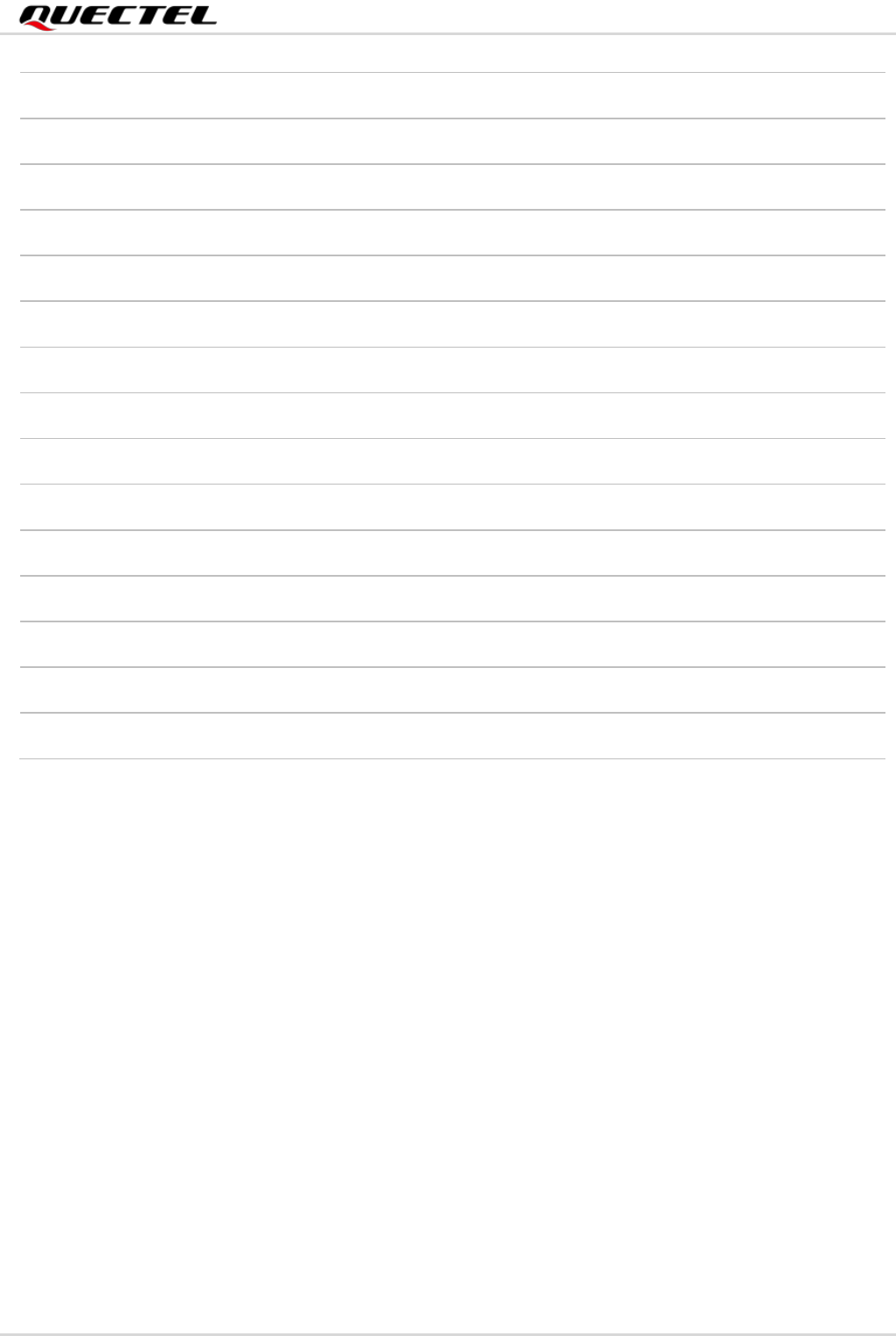
LTE Standard Module Series
EC200U&EG915U_Series_HTTP(S)_Application_Note 47 / 50
718
HTTP(S) socket write error
719
HTTP(S) socket closed
720
HTTP(S) data encode error
721
HTTP(S) data decode error
722
HTTP(S) read timeout
723
HTTP(S) response failed
724
Incoming call busy
725
Voice call busy
726
Input timeout
727
Wait data timeout
728
Wait HTTP(S) response timeout
729
Memory allocation failed
730
Invalid parameter
731
Wondblock
732
SSL Handshake Failed
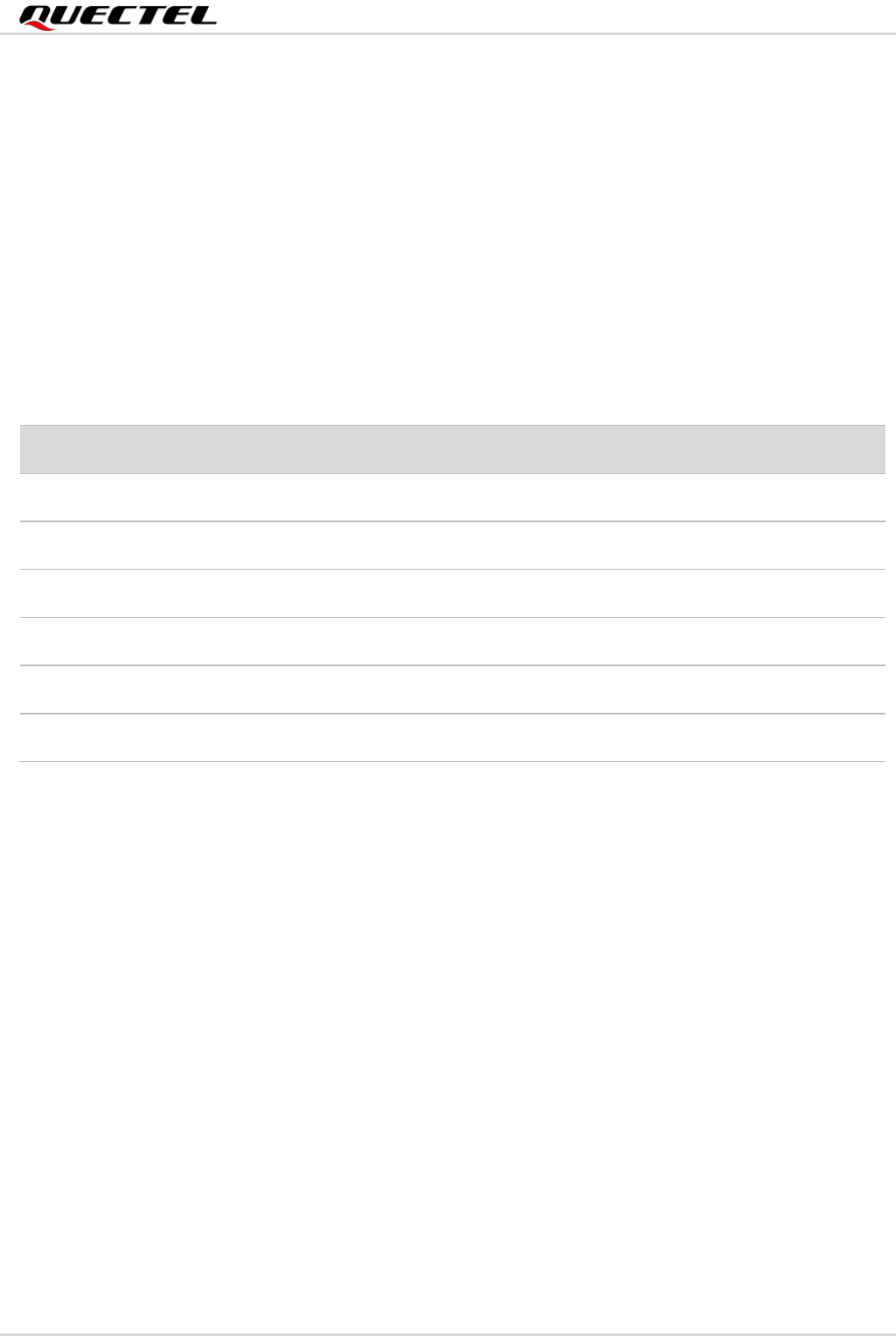
LTE Standard Module Series
EC200U&EG915U_Series_HTTP(S)_Application_Note 48 / 50
6 Summary of HTTP(S) Response Codes
<httprspcode> indicates the response codes from HTTP(S) server. The details about <httprspcode>
are described in the following table.
Table 3: Summary of HTTP(S) Response Codes
<httprspcode>
Meaning
200
OK
403
Forbidden
404
Not found
409
Conflict
411
Length required
500
Internal server error
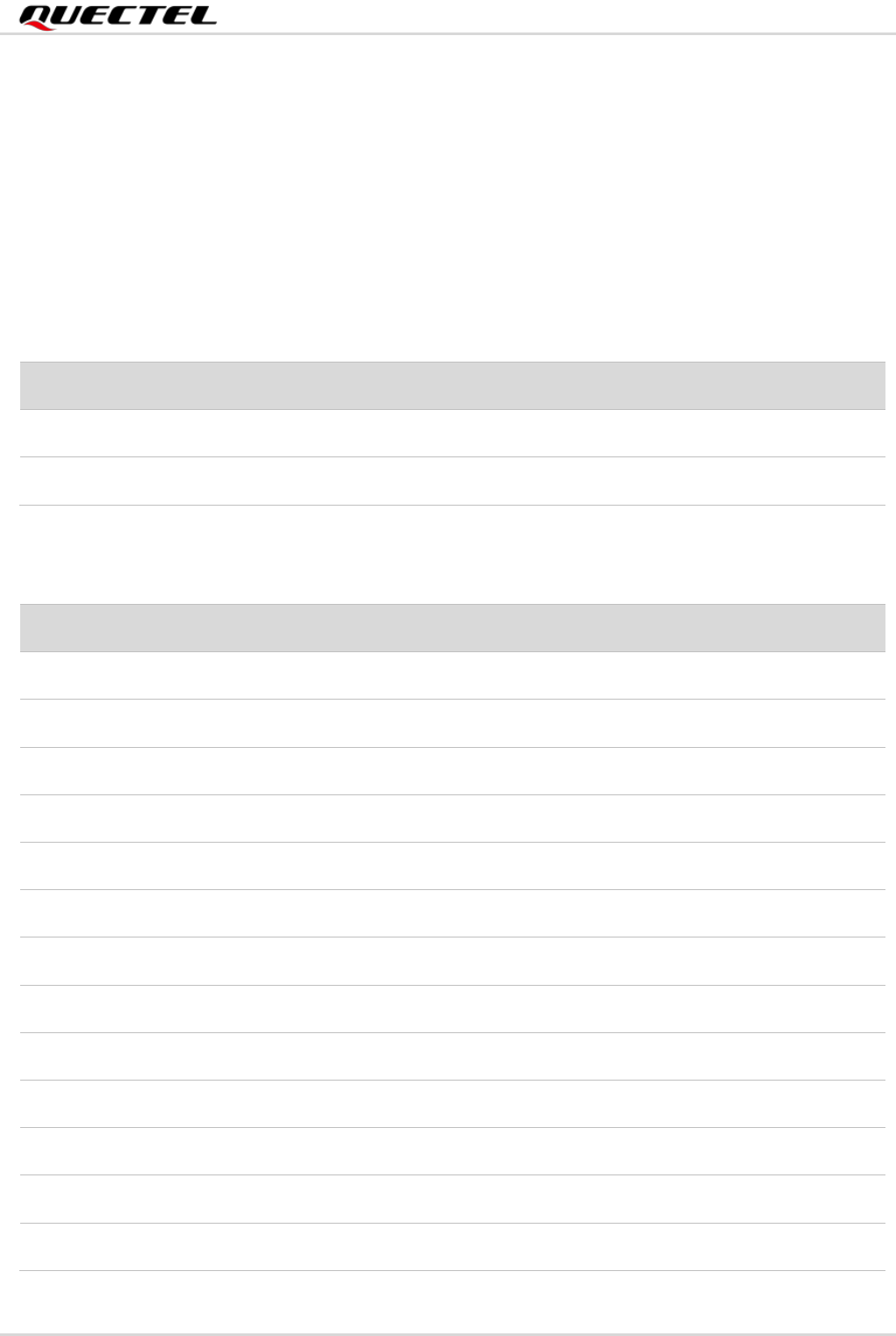
LTE Standard Module Series
EC200U&EG915U_Series_HTTP(S)_Application_Note 49 / 50
7 Appendix References
Table 4: Related Documents
Table 5: Terms and Abbreviations
Document Name
[1] Quectel_EC200U&EG915U_Series_TCP(IP)_Application_Note
[2] Quectel_EC200U&EG915U_Series_SSL_Application_Note
Abbreviation
Description
APN
Access Point Name
CA
Certification Authority
DNS
Domain Name Server
DTR
Data Terminal Ready
HTTP
Hypertext Transfer Protocol
HTTPS
Hypertext Transfer Protocol Secure
ID
Identification
IP
Internet Protocol
LTE
Long-Term Evolution
MCU
Microprogrammed Control Unit
PDP
Packet Data Protocol
PPP
Point-to-Point Protocol
PS
Packet Switch

LTE Standard Module Series
EC200U&EG915U_Series_HTTP(S)_Application_Note 50 / 50
SSL
Security Socket Layer
TA
Terminal Adapter
UART
Universal Asynchronous Receiver/Transmitter
URI
Uniform Resource Identifier
URL
Uniform Resource Locator
URC
Unsolicited Result Code
USB
Universal Serial Bus
(U)SIM
(Universal) Subscriber Identity Module
UFS
UNIX File System
